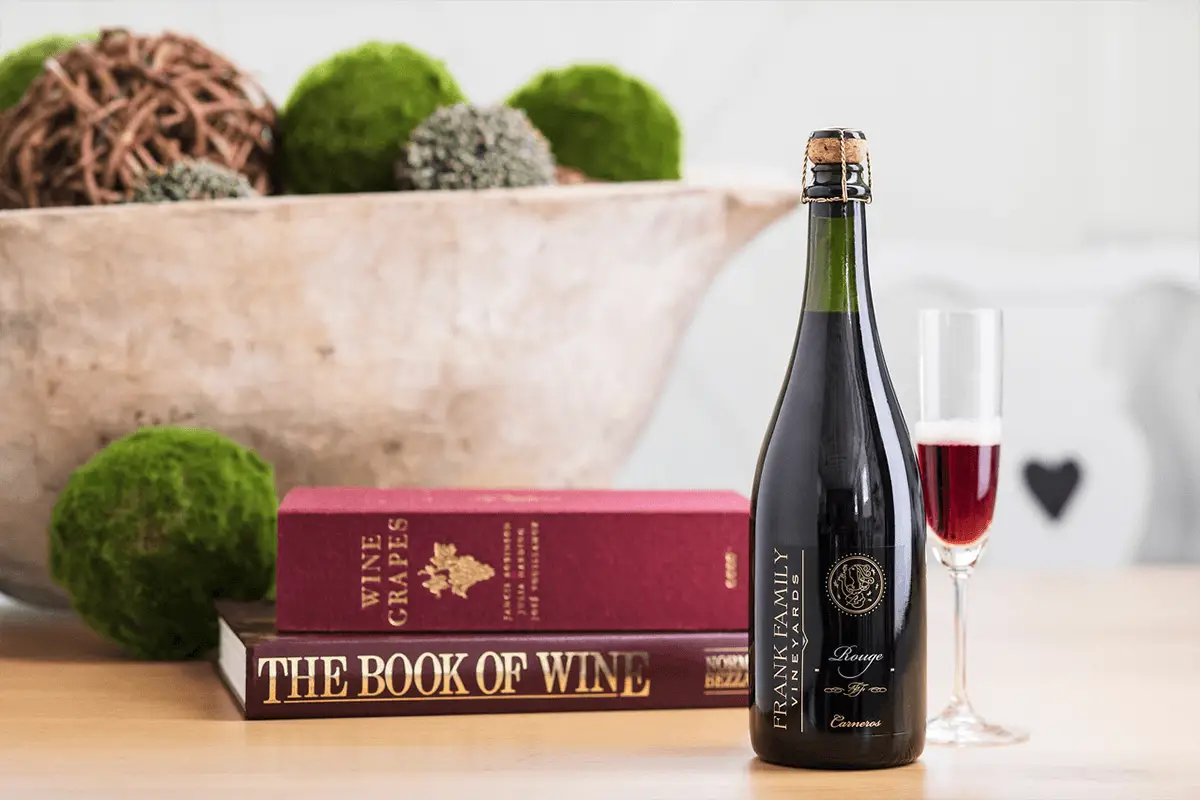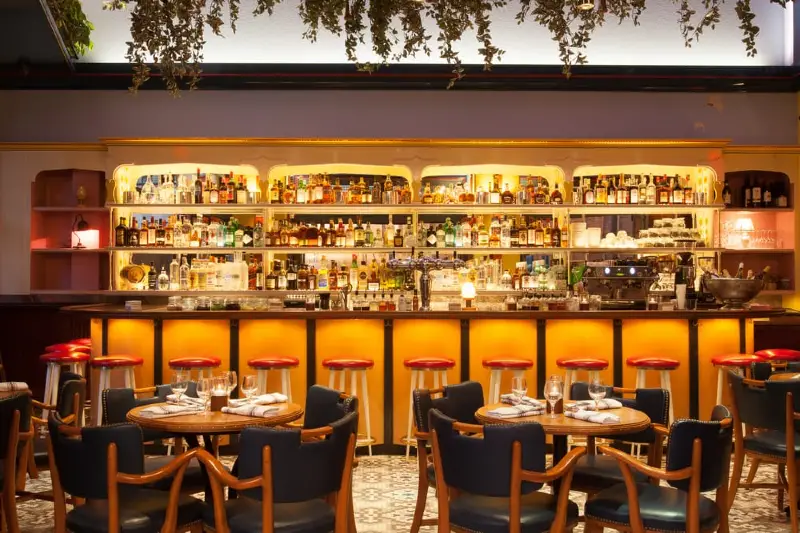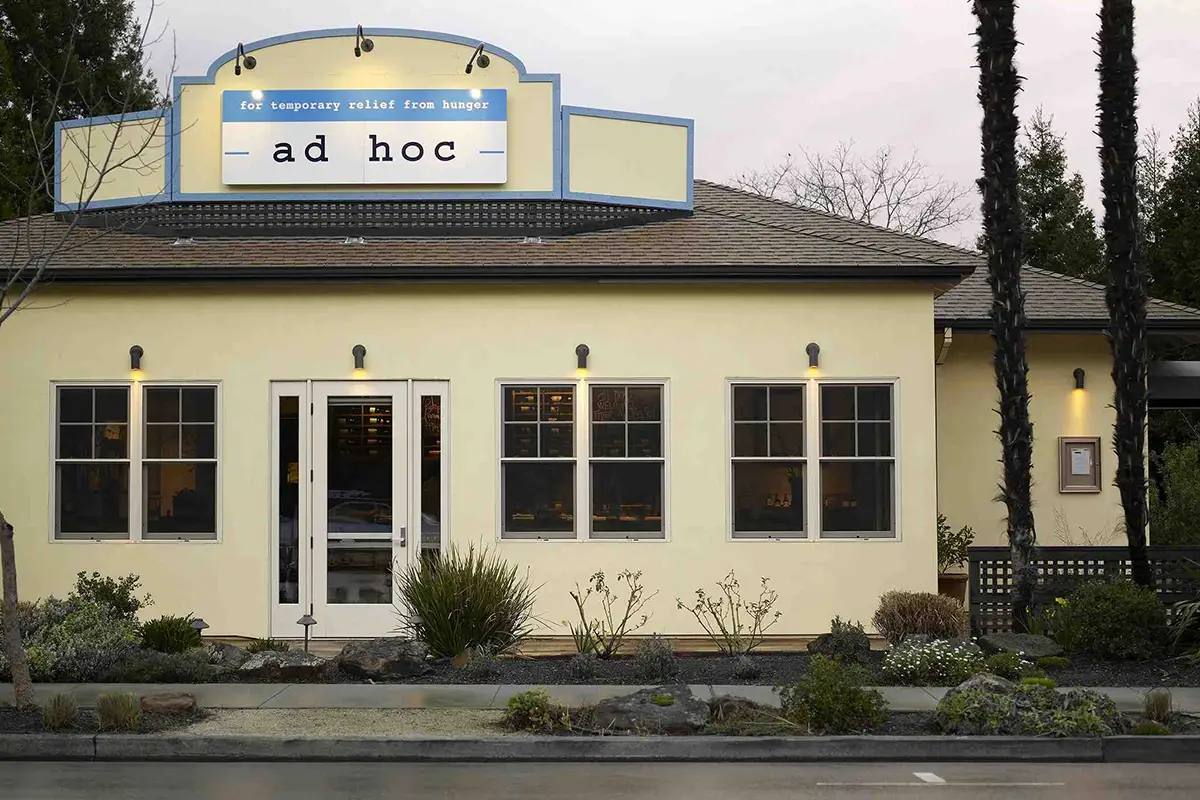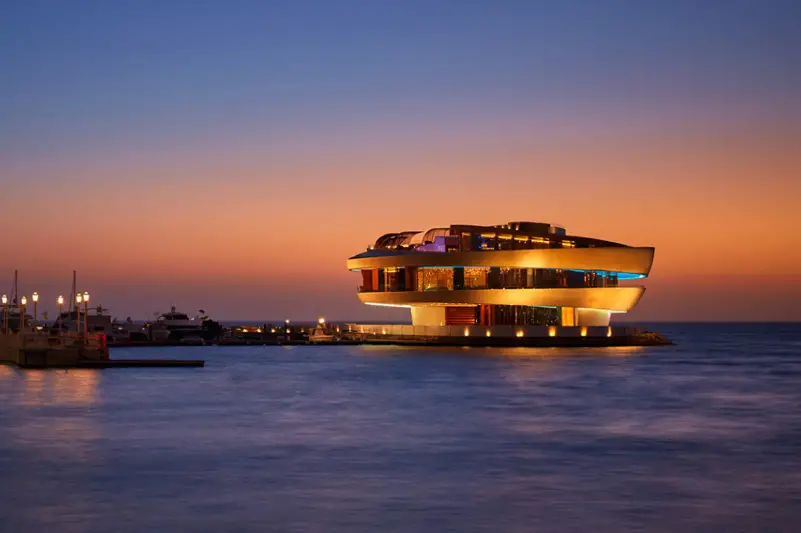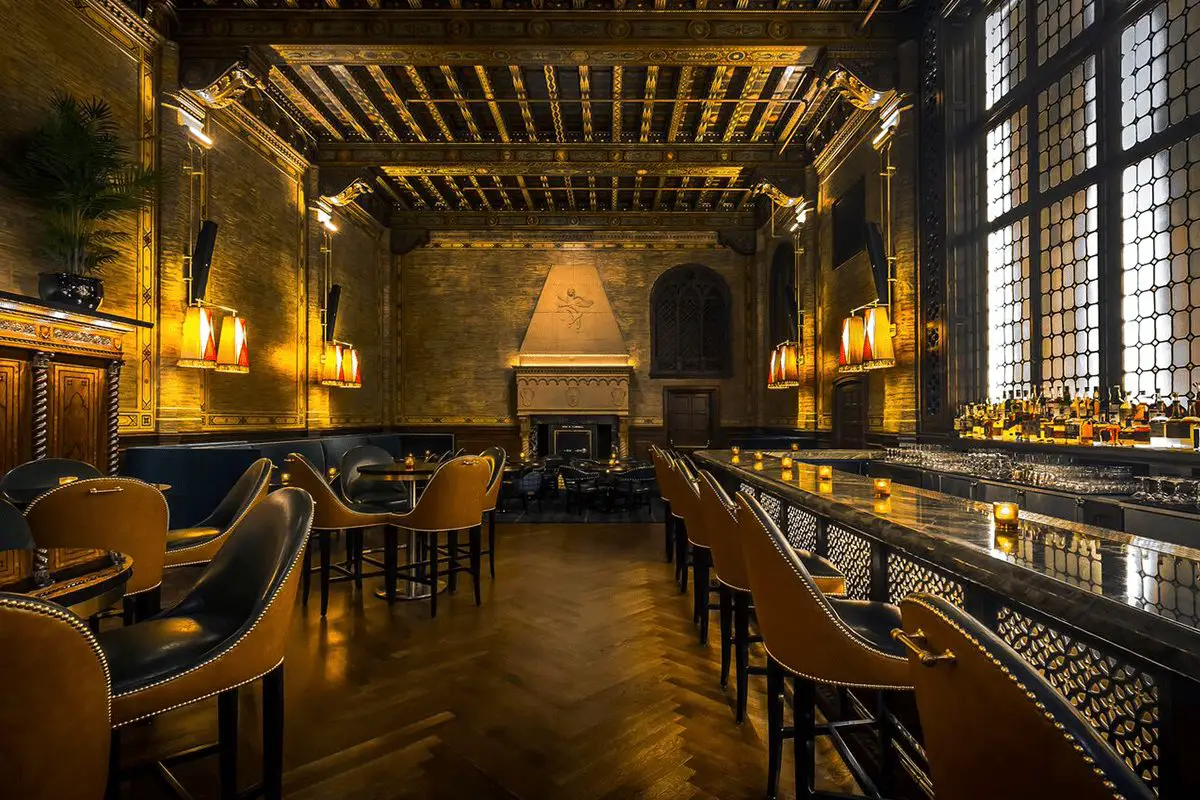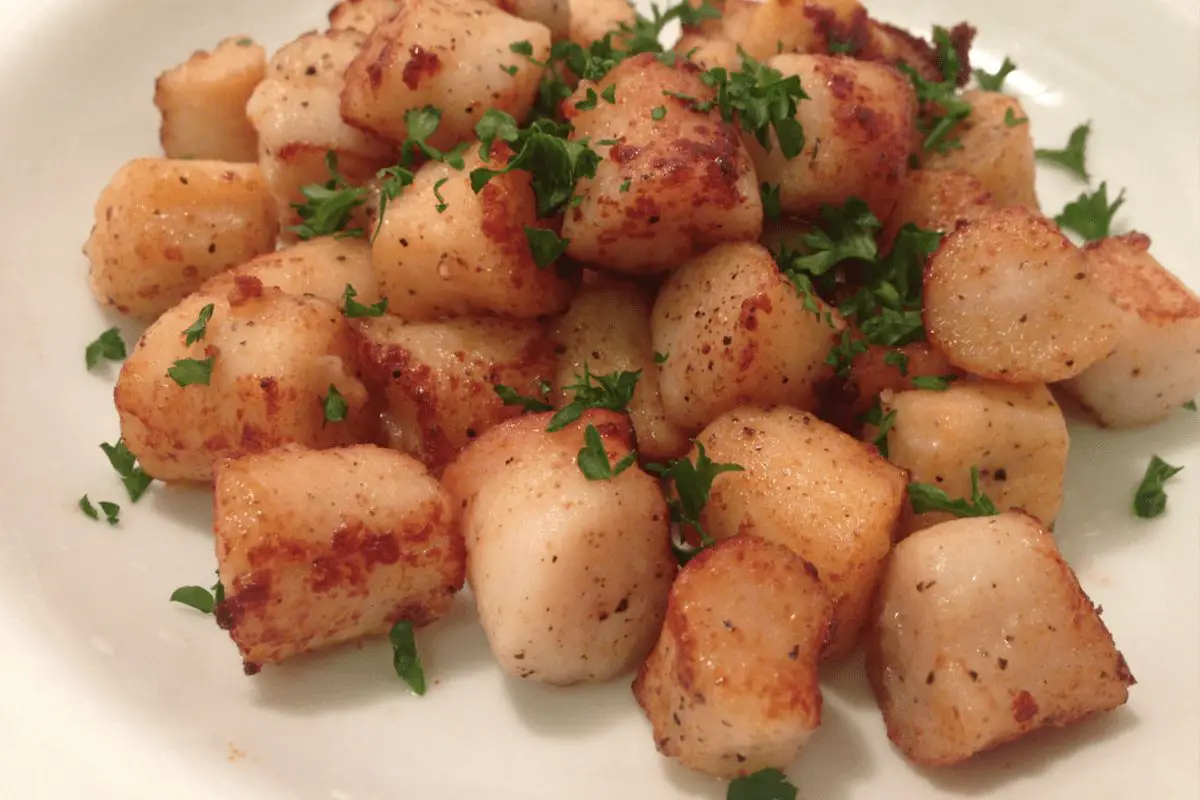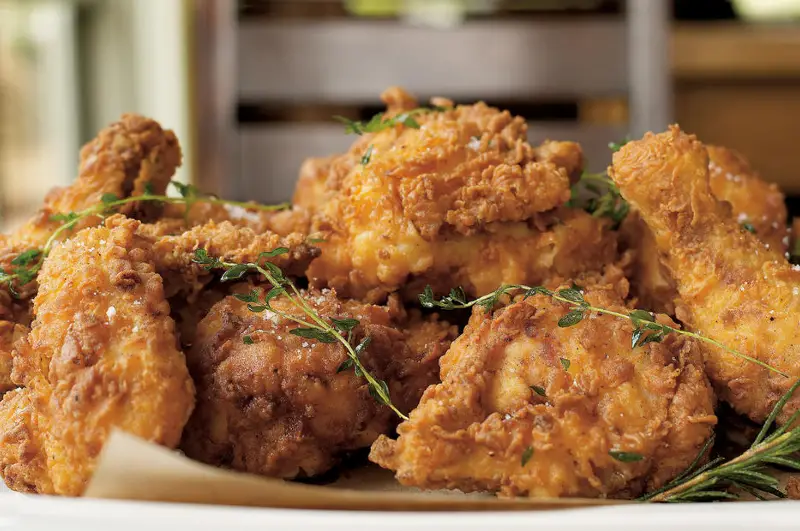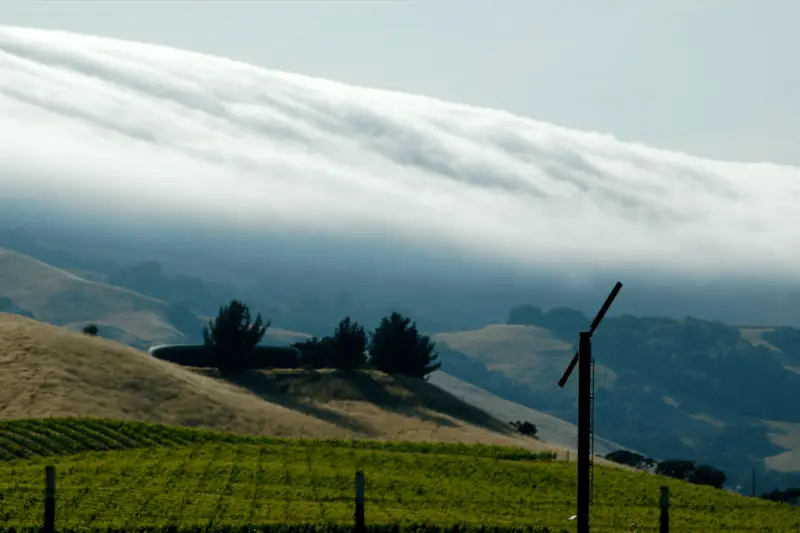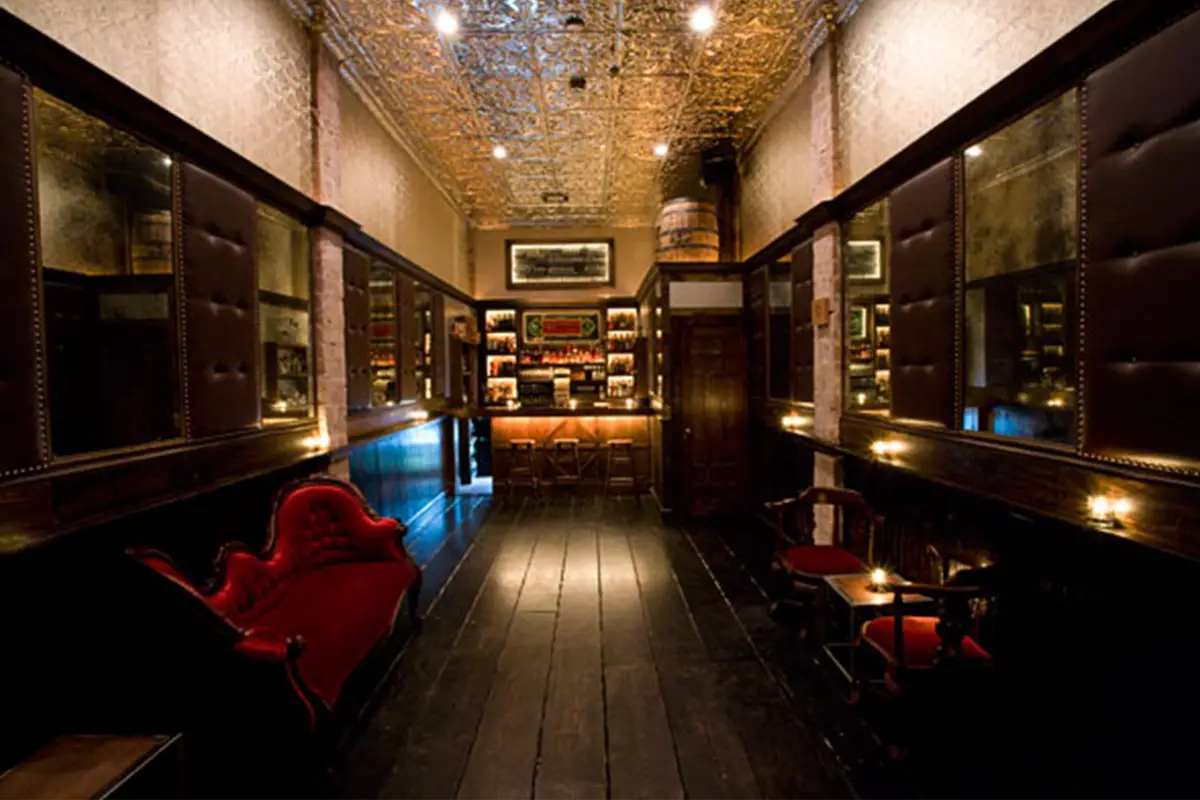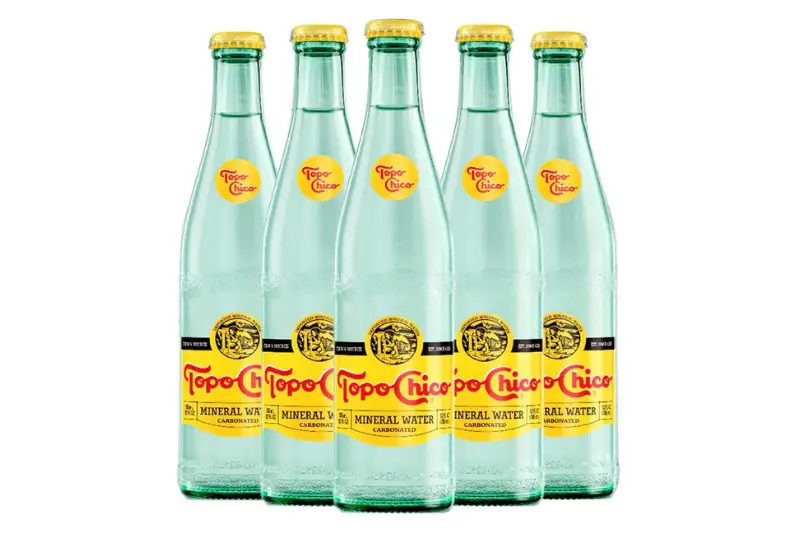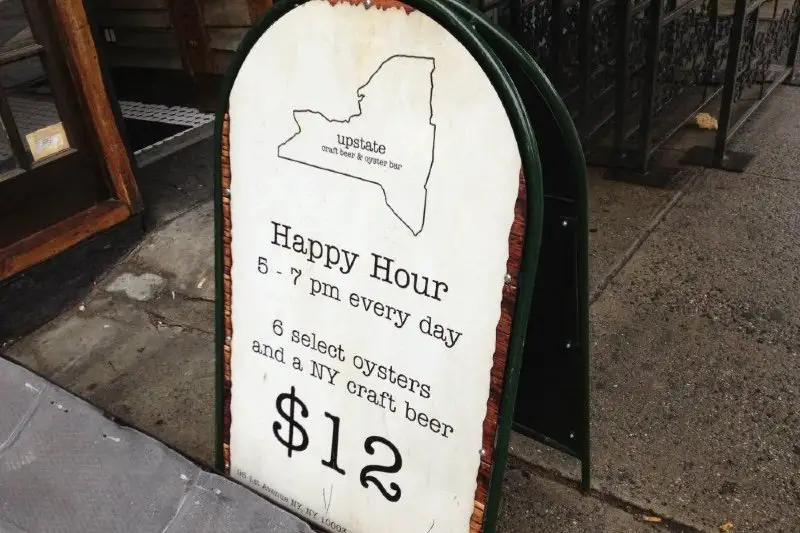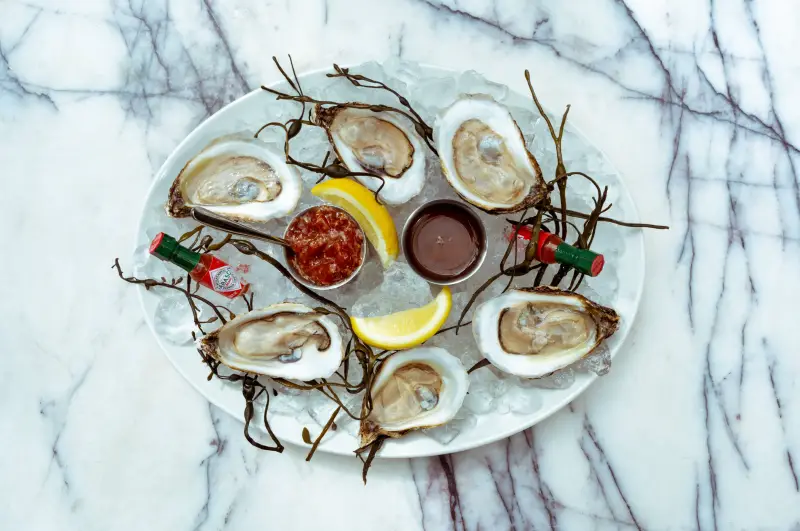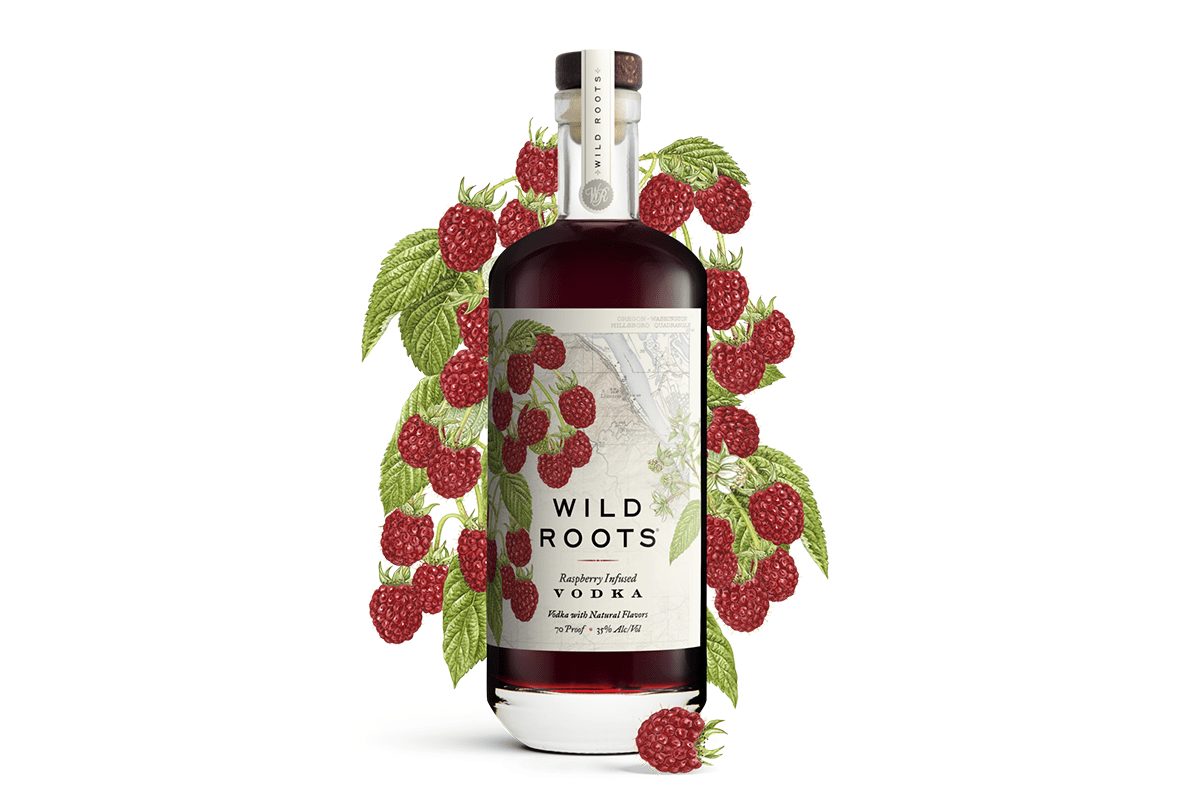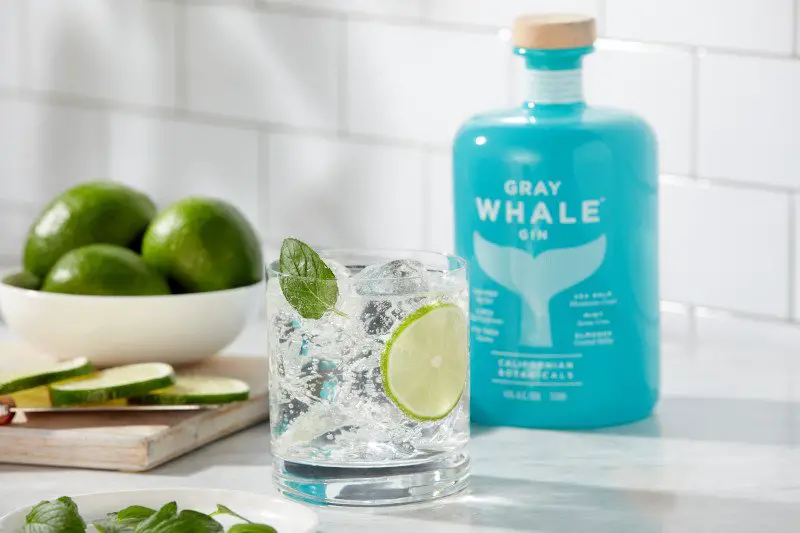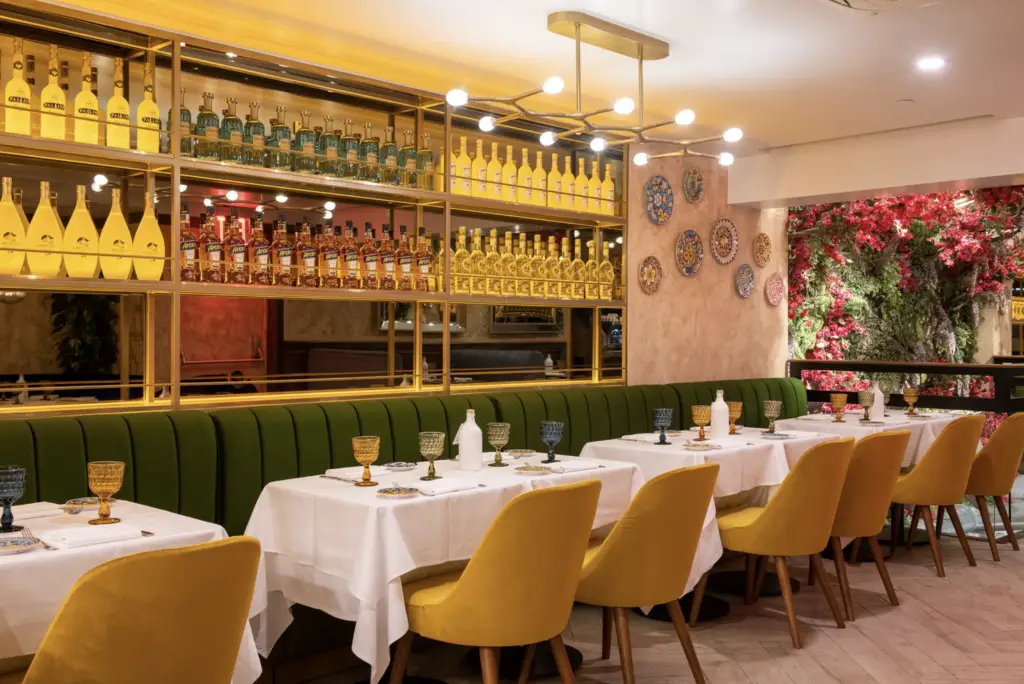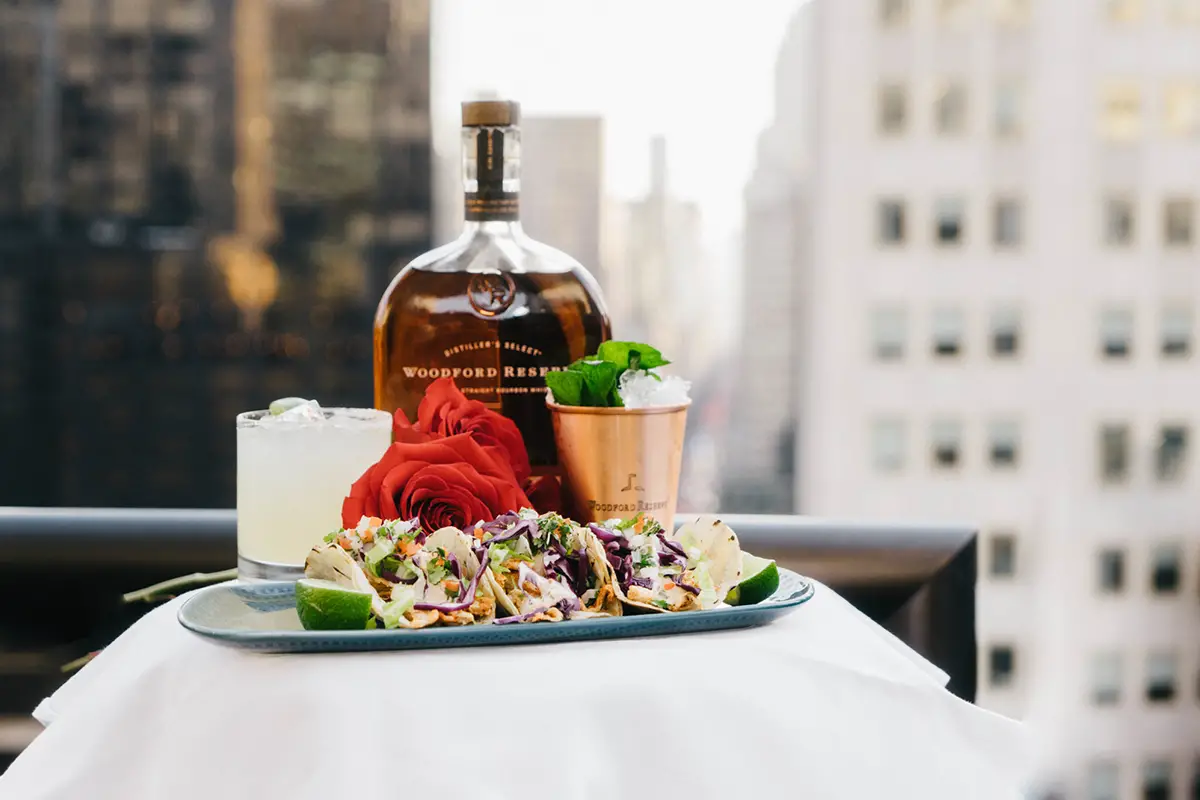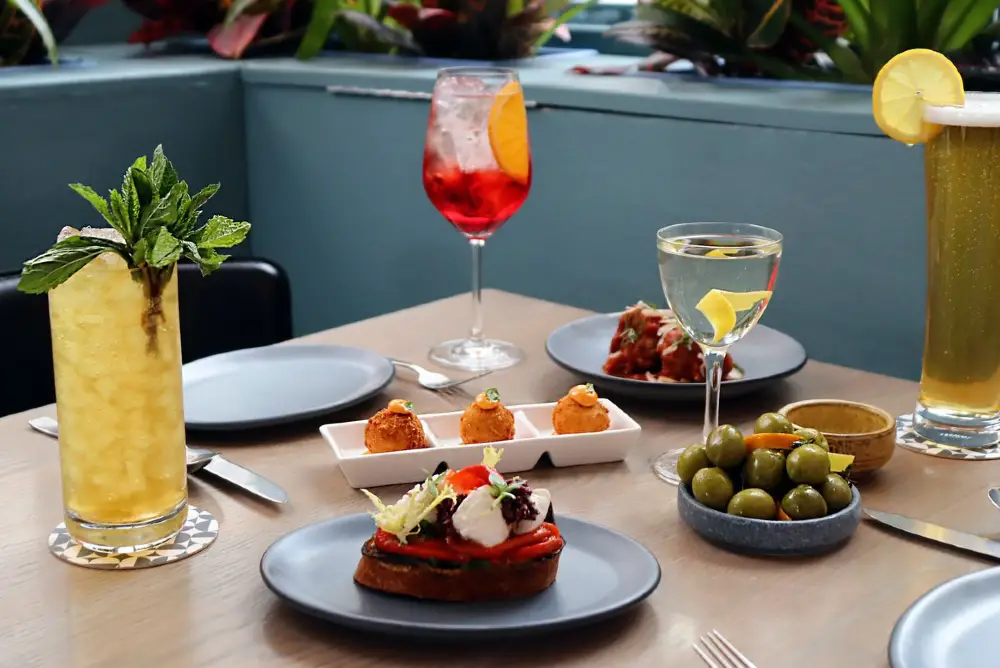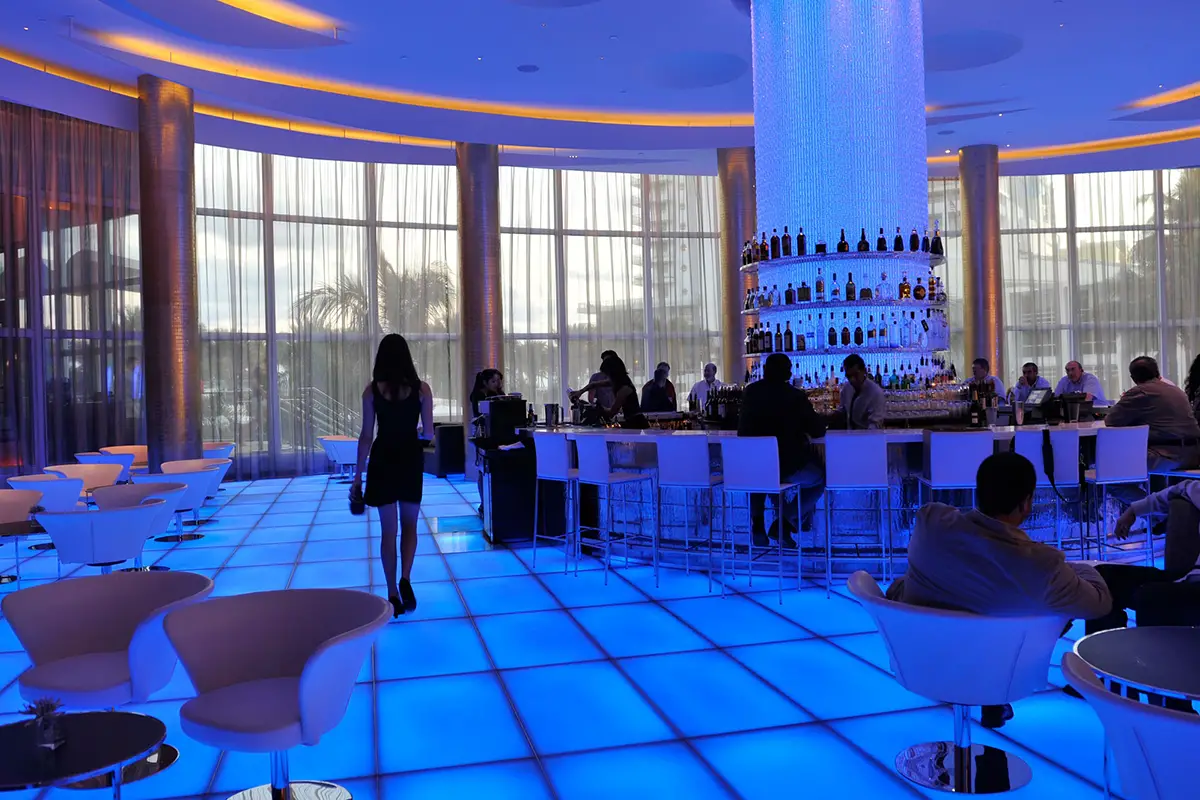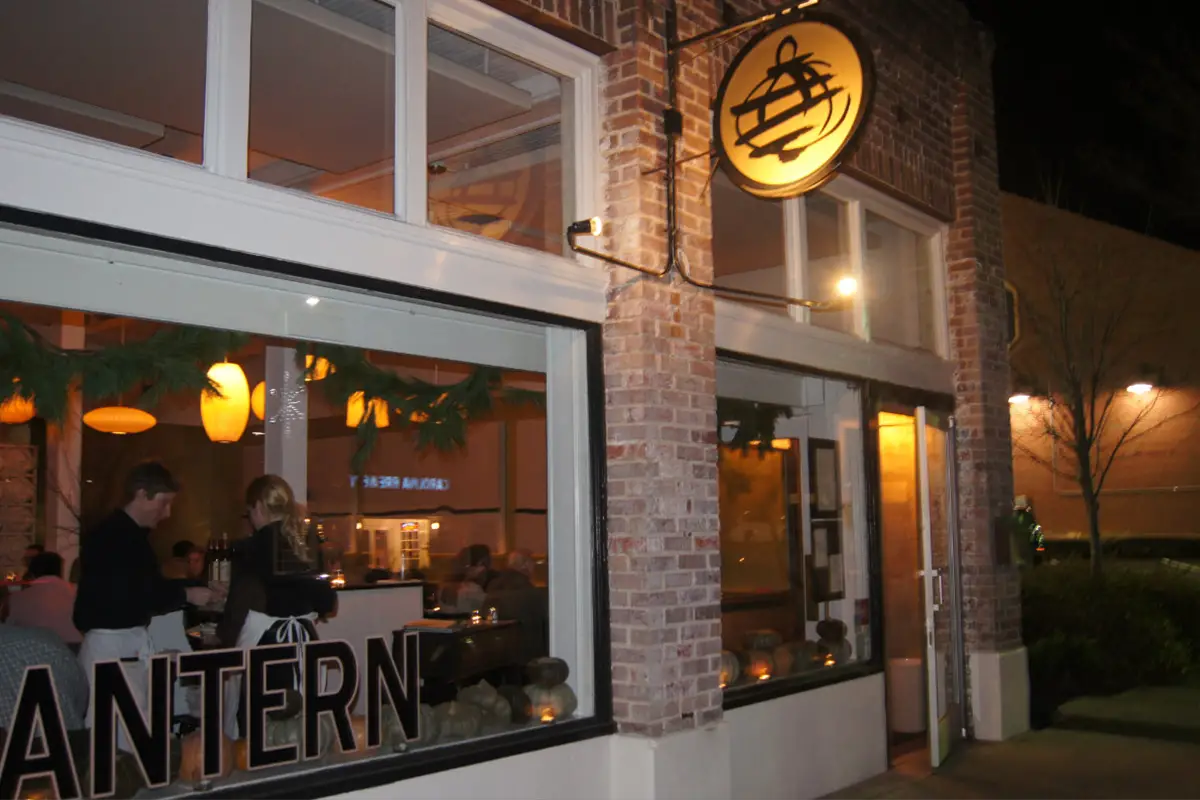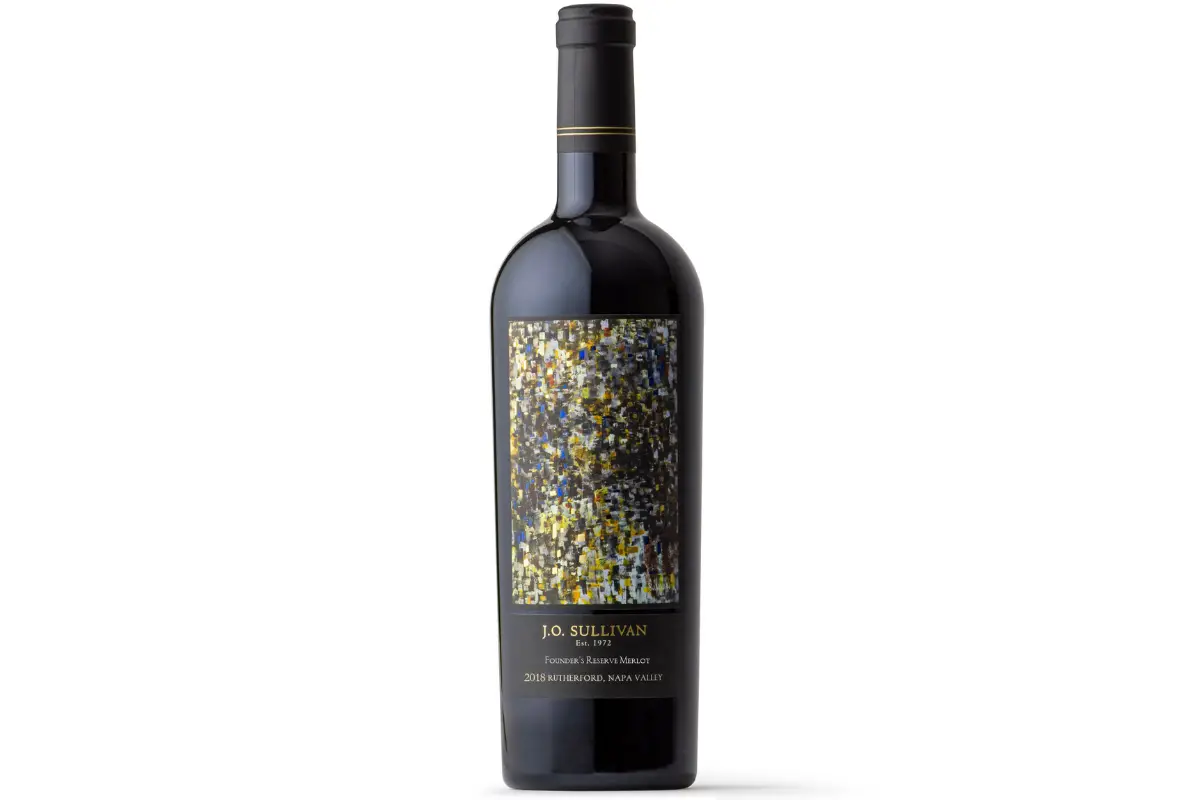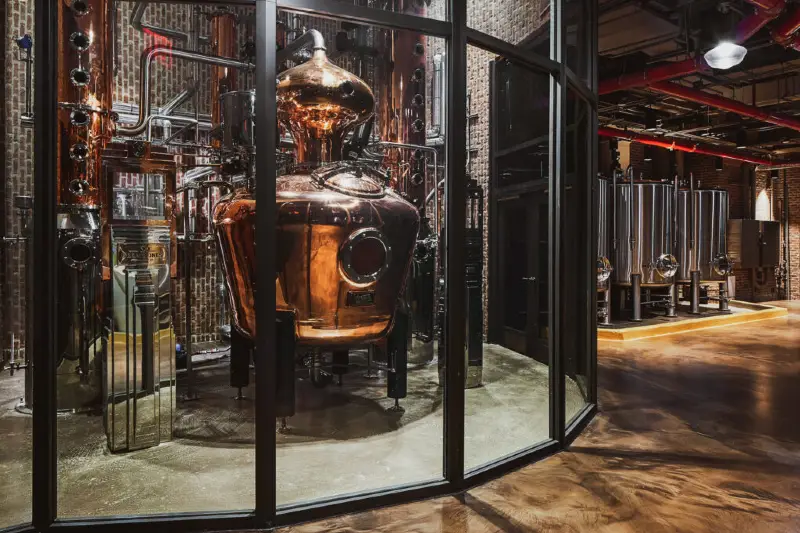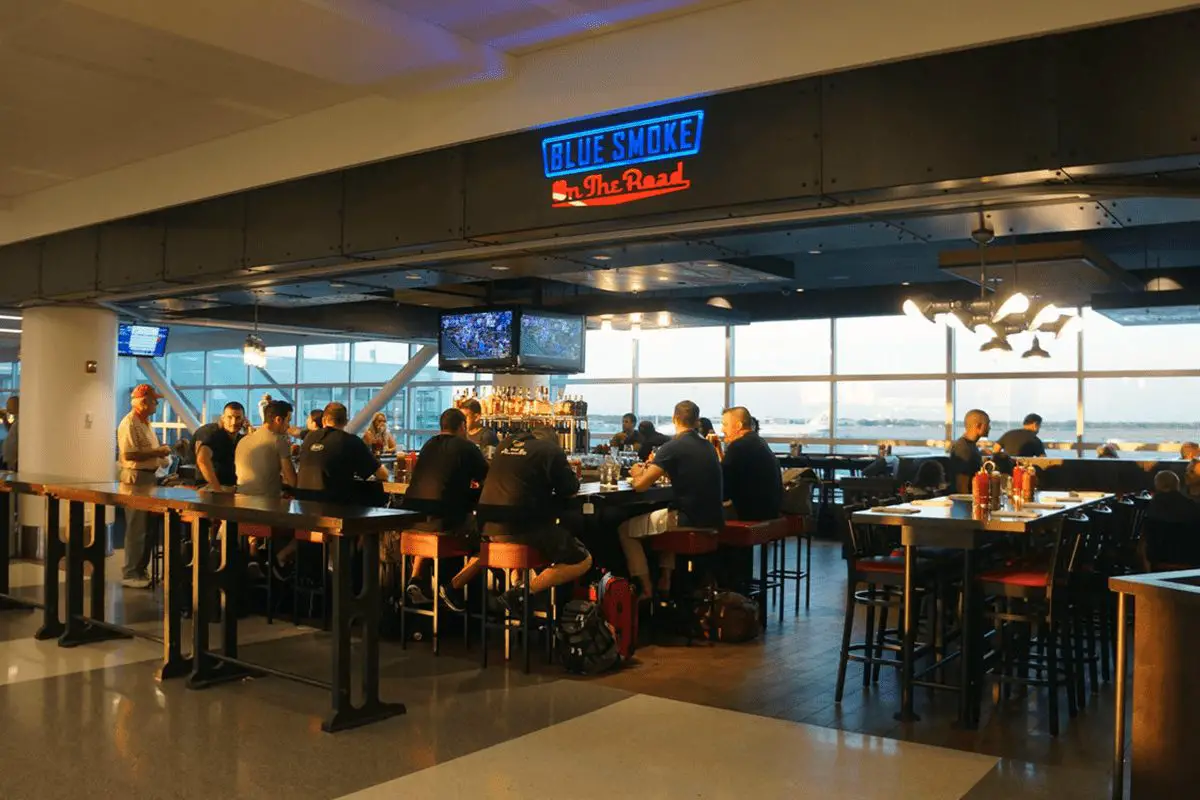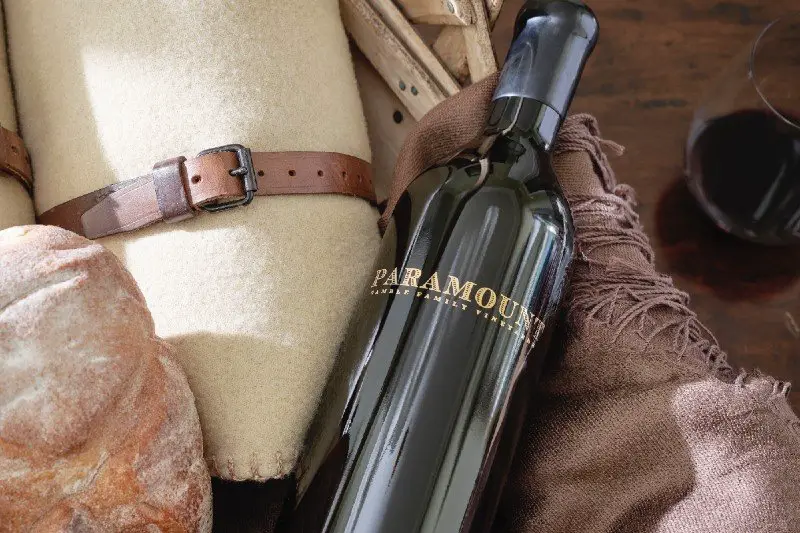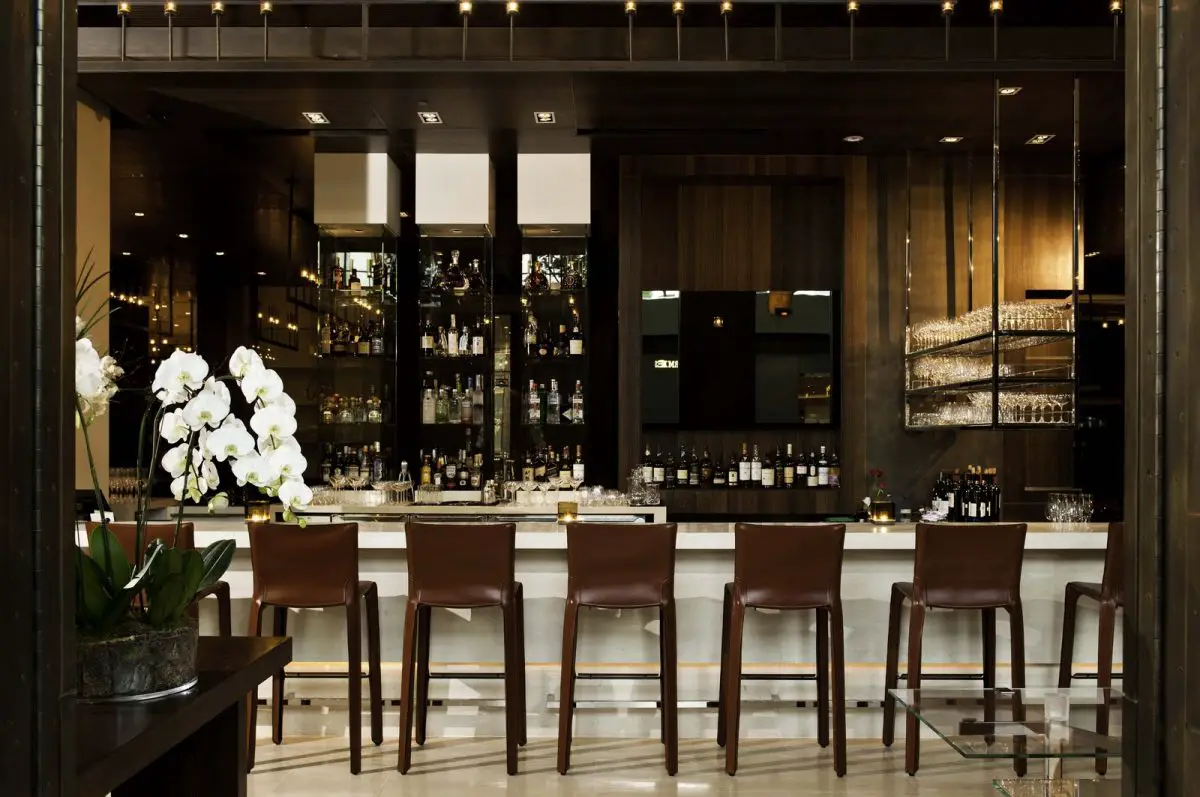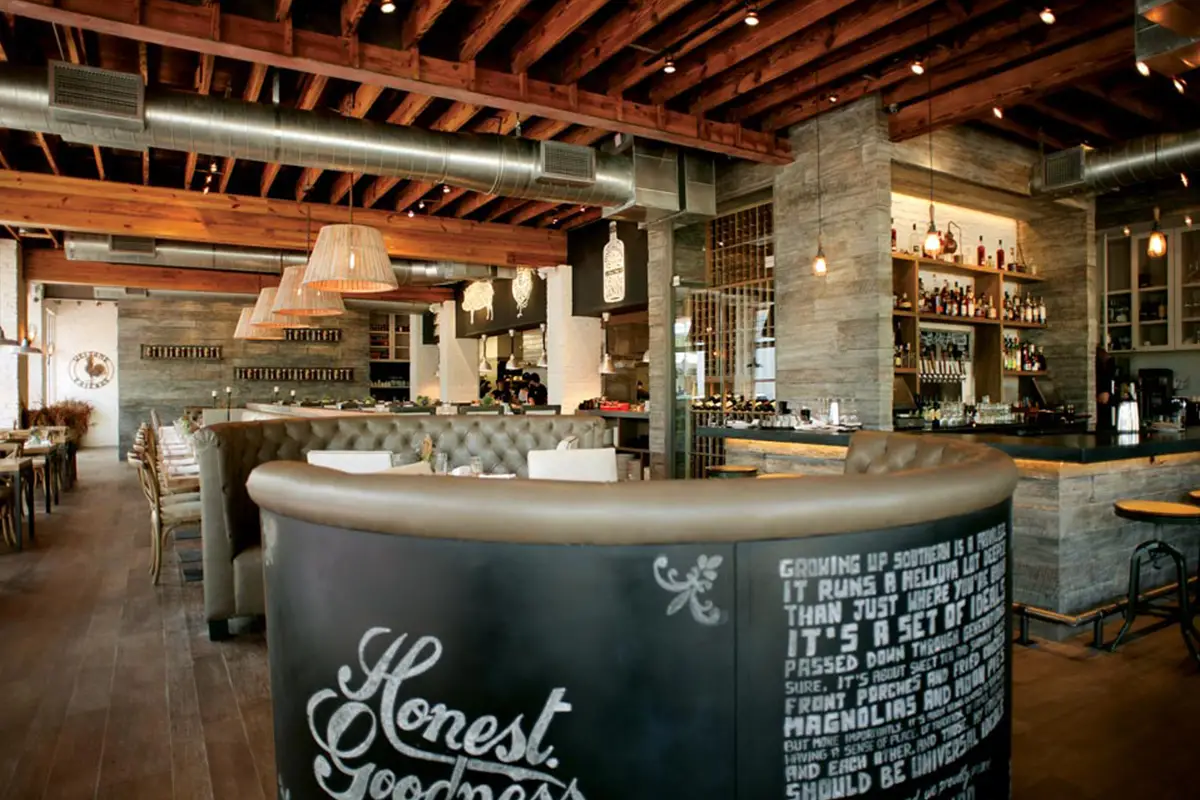One of Italy’s most refreshing and food-friendly wines, Lambrusco is an effervescent red wine from Italy that has taken some time to catch on in the U.S. but is finally starting to creep out of obscurity. Continue reading
 Small Bites in a Big City
Small Bites in a Big City
From authentic raw bars, to rooftop dining, to the cozy confines of Grand Central’s favorite speakeasy, here are some GLR articles dedicated to fun and easy NYC spots to grab small bites and great drinks in cool places.
Raw Bar Hopping – 8 Great Oyster Bars in NYC
The most coveted oyster varieties from both North American coasts are appearing on the menus of Manhattan eateries in fresher, tastier and more robust selections than ever before. Here’s our list of top eateries in NYC shucking these delicious and ecologically powerful bivalves, and more.
A Higher End Happy Hour at These Popular NYC Restaurants
From $2 Osyters at The Standard East Village to Buratta Toast at Great Jones Distilling Co, You Can’t Go Wrong at These Top Spots
With the weather slowly cooling down, it’s about time for New Yorkers to enjoy the after-work hours, easily sipping libations with co-workers or friends. Sometimes, what you need is something exceptional, yet uncomplicated. Here are 5 of our favorite happy hours that will be sure to please:

The Campbell At Grand Central—Still A Treasure Sans The Apartment
If you travel through Grand Central Terminal every day and find yourself scratching your head right now, don’t worry—that was sort of the point. Touted as one of Grand Central’s top hidden secrets by Travel + Leisure, this opulent space has never needed trickery to retain its speakeasy status.

6 Easy Rooftop Bars in NYC
Like any good idea in New York City, once it’s out, everyone wants in. The proliferation of rooftop bars and restaurants in NYC has been a great thing, as many hotels, restaurants and building owners have realized just how valuable their rooftops really are.

 This Once Sleepy Town in Napa Valley Has One of the Highest Concentrations of Michelin-rated Restaurants in the World
This Once Sleepy Town in Napa Valley Has One of the Highest Concentrations of Michelin-rated Restaurants in the World
The rows of Cabernet Sauvignon stretch as far as the eye can see. This is my first visit to California’s Napa Valley and like most first-time visitors, I am hopping from one storied winery to another, packing in as many tastings as I can in two days. But Napa isn’t just about wine. Continue reading
 Qatar is Home to a Stunning 26,000-foot Restaurant From This Famed Sushi Empire
Qatar is Home to a Stunning 26,000-foot Restaurant From This Famed Sushi Empire
The stunning 26,000-square-foot Nobu, the famed sushi empire from Michelin-starred chef Nobuyuki Matsuhisa, is part of the Doha Four Seasons and floats on its own mini-island in the Qatar Gulf, rising like a coiled shell crossed with a starship from the future.
Stunning Design
Inside, seven separate glamorously designed dining areas comprise a 134-seat main room, two private dining rooms, two bar lounges, and a 38-seat rooftop venue. Chef Nobuyuki “Nobu” Matsuhisa’s recipe for success combines his formal sushi training with a love of travel and global cuisine.


World-class Cuisine
The architectural masterpiece, designed by the NYC-based Rockwell Group, showcases the very best in fine dining, featuring Nobu’s world-famous cuisine matched by panoramic views of the alluring Arabian Gulf.
A practitioner of new-style Japanese cuisine, the Nobu menu includes innovative flavor pairings, such as yellowtail sashimi with jalapeño, lobster with wasabi pepper sauce, and perhaps Chef Matsuhisa’s most notorious recipe – the black cod miso.





Nobu Doha does nothing but impress. A destination as a whole; the world’s largest Nobu is not just a restaurant, its the venue for an entire evening.
Offering a truly exclusive culinary experience, found nowhere else, the tri-level Nobu Doha boasts the largest of its kind in the world and is the only Nobu at a Four Seasons in the Middle East.
 The Campbell At Grand Central—Still A Treasure Sans The Apartment
The Campbell At Grand Central—Still A Treasure Sans The Apartment
It’s no secret that Manhattan—and the thirsty masses who live in and travel to it day in and day out—love a good speakeasy. After all, potent drinks, exclusivity and Gatsby-esque charm will take you far in a city renowned for not sleeping and its endless waitlists.
 America’s Most Coveted Shellfish is Back
America’s Most Coveted Shellfish is Back
Move over Maine lobsters. An even more revered, more sought after New England shellfish has stolen the culinary spotlight for a few fleeting months. Fresh-caught Nantucket Bay scallops – arguably the best and most coveted seafood in America – are now arriving at select restaurants and seafood shops throughout the country, and they won’t be here for long. Continue reading
 Fried Chicken & Champagne at Thomas Keller’s Ad Hoc
Fried Chicken & Champagne at Thomas Keller’s Ad Hoc
If dining at a Keller establishment is a must, two other options exist in Yountville. Ad Hoc is much less expensive than the Laundry but still gets stellar reviews for its four-course menu of ever-changing selections featuring local ingredients.

Keller opened Ad Hoc in 2006 as a casual dining venue to showcase the American comfort food of his childhood. The name Ad Hoc literally means “for this purpose,” and derives from Keller’s original purpose for the restaurant—to temporarily fill a space while his team developed a different restaurant concept. Yet from the start, Ad Hoc was loved so much by the locals and visitors to the wine country alike that it stuck around and is now one of the most popular restaurants in the valley.

The daily-changing four-course menu, featuring classic American dishes like fried chicken, pot roast and barbeque, is handwritten nightly on chalkboards throughout the restaurant. All courses are served family-style to increase both the conviviality of the Ad Hoc experience and to further recreate the casual comfort of home. The wine list also features many of the local vintners—many of whom can be seen frequently dining at the low key restaurant.

Ad Hoc
6476 Washington St.
Yountville, Calif. 94599
(707) 944-2487
 California’s Hottest Wine Region is Also It’s Coolest
California’s Hottest Wine Region is Also It’s Coolest
If you’ve lived in California then you probably know how much the Pacific Ocean affects the air temperature. Coastal towns and cities can experience temperatures that are routinely 15-20 degrees cooler than locations just a few miles inland, and this juxtaposition is at its starkest in the summer. [Top Photo: Cathleen Evangelista]
 4 Speakeasy (Type) Bars for Winter Imbibing
4 Speakeasy (Type) Bars for Winter Imbibing
Speakeasies. They are, by definition, a little anachronistic. Although Prohibition ended long ago, drinking in secretive elegance will never really go out of style. Continue reading
 8 Versatile Wines to Pair With Your Thanksgiving Feast
8 Versatile Wines to Pair With Your Thanksgiving Feast
“Thanksgiving Wines” has become an annual favorite of mine to write. I enjoy the challenge of trying to find wines that pair well with a Thanksgiving meal—not as easy of a task as one might think.
I definitely favor white wines over red wines for this once-a-year meal, but the type of white wine you choose is key. The amount of oak is always something I wrestle with. On the one hand, the wine needs to be “big” enough to stand up to the richer aspects of the meal. Dark meat turkey, gravy and even a green bean caserole all call for bigger style whites. This usually means white wines with ample oak that have gone through some malolactic fermentation. As such, California Chardonnays can be a wonderful pairing for this meal, however I lean towards the less oaky ones with ample acidity to cut through the fattiness of the meal. For 2022, I have two Chardonnays listed (both from California).
Versatility and minerality are equally if not more important. Thanksgiving is a motley group of foods with a lot of different dishes serving as supporting cast to the main actor, turkey with gravy. This means you need a wine that can go with myriad flavors (sweet, salty, savory), with plenty of minerality and acidity to pair with the fattier apsects of the meal.
Alas, here are my 2022 “Thanksgiving Wines” selections, with a variety of price points (ordered by least – most expensive) from a variety of regions.
Chapoutier ‘Bila-Haut’ Cotes du Roussillon Blanc 2020 (SRP $15)

A blend of Grenache Blanc, Roussanne, Macabeu, Vermentino and Marsanne, this Cotes du Roussillon Blanc from world-class Rhone Valley producer M. Chapoutier, is round and rich, yet balanced with good minerality, ample acidity and tons of bright flavors. Alluring white peach, quince and lemon zest give way to saline and limestone notes on the finish.
A versatile wine for food pairing, you can serve this with your Thanksgiving meal or with hors d’oeuvres before. With an average SRP of $15 (even lower at some discount stores) this is also a wine you should consider buying a case of for Thanksgiving and the Holiday season.
2021 Garofoli Supèra Verdicchio Di Matelica DOC (SRP $16)

Dating back to 1871, Garofoli is the oldest family-owned winery in the Marche region of Italy. While Garofoli may be an old winery, the Supèra is relatively new and the winery’s first foray into Verdicchio di Matelica.
The grapes for this Verdicchio are from the higher elevation Matelica Valley where the Garofoli family is working with a young and innovative grape grower. Referred to as a “mountain wine” by Garofoli, this Verdicchio teams bright and tangy notes of lemon peel and tangerine with mellower notes of pine nuts and bread pudding.
2021 La Valentina Pecorino Colline Pescaresi IGT (SRP $18)

Established in 1990, La Valentina is a good example of the modern winemaking renaissance happening in Abruzzo, a region long undervalued for its quality wine production. A true believer in sustainability, the winery avoids the use of artificial or chemical products and estate vineyards are farmed organically (or in transition towards organic).
The Pecorino grape thrives in the rocky slopes and maritime climate of Abruzzo—the areas clay, limestone, and gravel soils and microclimates a great mix for a grape that is known for being difficult. but more than worth the effort.
The light hue of this wine (very pale yellow) is misleading. Citrus, stone fruits, minerals and acidity literally explode out of the glass, with very little oak presence—which I love. Like the ‘Bila-Haut,’ this is a versatile wine that will match with your smorgasbord of Thanksgiving spoils, but can also be served as a cocktail wine beforehand.
2020 Trivento Golden Reserve Malbec (SRP $20)

I have always liked Malbec as a plush, soft tannin, mellow alternative to bigger Bordeaux varietals like Cabernet Sauvignon. However, I have always felt there was a ceiling to its quality. That is before I met Germán di Cesare, chief winemaker at Bodega Trivento—one of Argentina’s top Malbec producers, in the foothills of the Andes Mountains. Both of the reserve Malbecs I tried were extrememly approachable, complex and paired beautifully with our lunch at mid-town Manhattan’s L’ Amico restaurant.
Their Eolo Malbec is the best Malbec I have ever tried, but at $100 it is very expensive for a Malbec—especially for Americans who typically think of Malbec as a relative value. At $20 though, their “Golden Reserve” is VERY good and a great value. This wine reminds me of a Napa Valley Boardeaux-style blend, with dark red fruits, anise, tobacco and spice box wafting out of the glass. This wine is very structured for a Malbec, with soft, yet prevalent tannins and complex flavors shaping it the whole way through.
2020 Inama “Carbonare” Soave DOC Classico (SRP $30)

Inama’s vineyards cover 70 acres throughout Soave Classico, mainly on and around the dormant Monte Foscarino volcano.
The region’s soil owes its characteristic to a stream of water that flows underground in the region. According to Inama, “the basalt, which characterizes the ground in most of the Soave Classico area, has great chromatic complexity…the strong character of the vineyard is evident in the grapes.”
Aromas of citrus and fresh cut flowers greet you with this Soave, followed by effervescent acidity, strong minerality and a little bit of limestone salinity on the finish—which I love! This Soave can easily stand up to your turkey and gravy while also complimenting your sides, from sweet potatoes to green bean casserole.
2021 Frank Family Carneros Chardonnay (SRP $40)

I’ve written about Frank Family wines before and for good reason—they are very good, VERY consistent and generally available Napa Valley wines at reasonable prices.
The grapes for this wine were sourced from some very reputable vineyards—primarily their estate Lewis Vineyard as well as neighboring Beckstoffer Vineyards (Napa-Carneros) and Sangiacomo Vineyards (Sonoma-Carneros).
This wine has a rich bouquet of baking spices, apple pie and Meyer lemon upfront. While only seeing partial malolactic fermentation, this prototypical Carneros chardonnay is full bodied, with pineapple, peach, and brioche bread notes upfront. Plenty of bright acidity and subtle hints of oak are revealed on the long finish. Frank Family’s “Lewis Vineyard” Chardonnay is also worth seeking out if you can find it and don’t mind the higher price point. Pineapple, pear, tangerine and vanilla custard notes are shaped by impeccable structure, ample acidity and a super long finish. This is one of the better California Chardonnays I have tried but you might need to order it directly from the winery.
Fiddlehead “Oldsville” Willamette Valley Pinot Noir (SRP $54)

Founded in 1989 by winemaker Kathy Joseph, Fiddlehead Cellars stands out as one of California’s pioneering producers dedicated to terror-driven and age-worthy wines tied to great vineyard sites. Running the winery 30-plus years, Kathy is one of Santa Barbara County’s first leading female winemakers to own both her own winery and vineyard, with a hands-on role in the farming, winemaking, and other aspects of the business.
While Fiddlehead is famous for their Santa Barbra County wines, they have also been producing outstanding Pinot Noir in the Willamette Valley for nearly 30 years. Their Oldsville Pinot Noir is indicative of Kathy’s attention to making wines that are an expression of their vineyard sites—in this case terrior driven, Burgundian-style Willamette Valley Pinot Noir.
This classic Willamette Valley Pinot is packed full of blueberries and pomegranates with undercurrents of strawberries and lavender and complimented by earth, leather and smoked meat notes. The wine finishes with tobacco, spice box and just a hint of vanilla oak—with great structure and a long, lingering finish. This Pinot Noir is a perfect match for lamb chops but will also work well with your Thanksgiving feast.
Lynmar 2018 Quail Hill Vineyard Chardonnay (SRP $63)

At the heart of Lynmar Estate is its original site, the 47-acre Quail Hill Vineyard, one of the foremost vineyard sites within the Russian River Valley. Planted in 1974, proprietor Lynn Fritz acquired the site in 1980 as a rural retreat from running an international corporation in San Francisco. Upon tasting some of the original wines sourced from Quail Hill, made by Merry Edwards at Matanzas Creek and Tony Soter at Étude, Lynn began to fully understand the site’s rare qualities. Today it remains one of the top vineyards in Russian River for world-class Chardonnay and Pinot Noir.
This wine is quintessential, top-tier, Russian River Chardonnay. Tropical and citrus fruits give way to peach, pear and crème brulee, with bright acidity and limestone minerality on the finish.
 A Higher End Happy Hour at These Popular NYC Restaurants
A Higher End Happy Hour at These Popular NYC Restaurants
With the weather slowly cooling down, it’s about time for New Yorkers to enjoy the after-work hours, easily sipping libations with co-workers or friends. Sometimes, what you need is something exceptional, yet uncomplicated. Here are 5 of our favorite happy hours that will be sure to please:

ALDAMA
Mexican hot spot Aldama is the perfect place to sip perfectly crafted cocktails, made under partner and beverage director Christopher Reyes (formerly of Employees Only and Cosme). Aldama is offering happy hour every day of the week from 5 pm to 7 pm, with refreshing, $8 cocktail creations like the Citrus Fizz and the staple Margarita, and snacks like tacos, guacamole, and ceviche tostada available for $10.

BUBBY’S
A Tribeca staple for over 30 years, Bubby’s is well-known for its family-friendly brunch, but a happy hour at Bubby’s shouldn’t be missed. Grab a seat at the bar, and choose from a selection of wine, beer, or classic cocktails (Margarita, Negroni, Pickled Martini, Rye Manhattan) available for $10, and hearty snacks include nachos, mac and cheese balls, chicken wings, and deviled eggs for only $7.

THE STANDARD EAST VILLAGE

KATANA KITTEN

Great Jones Distilling Co.
You will want to check out Great Jones Distilling Co.’s very own happy hour, dubbed “Prohibition Hour” where all cocktails (like the Hangar One NY Vodka Fruit Cobbler) and light bites, such as local burrata toast, smoked bacon croquettes, and BBQ chicken wings are $11 from Tuesday-Friday from 4-7 pm.
 How This Mineral Water Went From Local Cult Favorite to Worldwide Phenomenon
How This Mineral Water Went From Local Cult Favorite to Worldwide Phenomenon
Founded in Monterey, Mexico in 1895 Topo Chico’s uber-bubbly mineral water is now a world-wide brand. The story of this seemingly innocuous sparkling water that was born in Mexico, raised in Texas and is now flourishing on multiple continents—thanks in part to its acquisition by Coca Cola in 2017—dates back over 125 years.
History of production and relationship with Coca-Cola
Speaking of its parent company Coca Cola, Topo Chico and Coca Cola have a relationship that dates back about 100 years. In fact, long before Coke acquired Topo Chico, Topo Chico actually acquired the licensing rights to bottle Coke in Mexico, roughly 100 years ago. Needless to say, they have been working with Coke for many years so it’s not a big surprise that Coke decided to acquire them.
When Topo Chico was founded in 1895, it sourced and bottled the water from a spring near a small mole-shaped hill that it was named after. “Topo” means “mole” in Spanish and “chico” means “small.” 127 years later, it still sources water from the very same “Cerro del Topo Chico” spring.
The minerals matter
Topo Chico is not just ordinary sparkling water, like seltzer or club soda. It is actual mineral water, containing naturally occurring minerals and electrolytes like Sodium, Calcium, Magnesium, Potassium and Manganese. For comparison sake, “La Croix” sparkling water (another popular brand) is simply seltzer and does not contain any minerals. So what’s so special about these minerals? Sodium is needed for blood regulation (absence can cause serious impairment of bodily functions), regulates bodily fluids and transmits electrical impulses in the body; Calcium is an important nutrient and major component for bones and teeth; Magnesium aids in digestion, helps muscles recover and promotes a sense of calm; Potassium provides fuel for the heart and promotes kidney and nervous system function; Manganese is an antioxidant that benefits your bones and increases collagen production (healthy looking skin).
I’m not saying drinking Topo Chico everyday will solve any of your health problems but it certainly won’t hurt and the extra mineral intake could have some positive effects—if nothing else the electrolyte-laiden water will help keep you hydrated.
It now comes in 3 flavors but you may like the original
In addition to their original unflavored version, TC also comes in three litely flavored mineral waters; Twist of Lime, Twist of Grapefruit and Twist of Tangerine—all zero calorie.

While Topo Chico’s flavored versions are quite popular, their original unflavored water tastes quite good too. The naturally occuring carbonation, while plenty effervescent (more on this in a sec), has a softer mouthfeel than other sparkling waters, as if the bubbles are smaller but greater in quantity, leading to a texture that is mellow and inviting. Also, despite the minerals, TC also has a very mild, neutral aftertaste, if any at all—something I would imagine most people want in a sparkling water. I know I do. Less is more when it comes to a water’s taste.
It all about the bubbles
While less may be more on the aftertaste, more is more when it comes to carbonation. Yes, Topo Chico’s secret weapon—you guessed it—is in its bubbles. Simply put, the naturally occering carbonation in Topo Chico is more explosive and lasts longer than other brand I have tried. No wonder it is a cult-favorite for consumers and bartenders alike who like a vibrant Vodka Soda or Tom Collins with ferocious fizz that doesn’t go flat.
Leave an open bottle of TC out overnight and the next day it will taste like you just opened it. And while all mineral waters naturally contain sodium—which can be off-putting to some people—the sodium level in TC is fairly low and provides a thirst-busting sensation (Gatorade’s secret thirst busting recipe has ample sodium for a reason).
What is Ranch Water?
You cannot make an authentic Ranch Water cocktail without Topo Chico. What is a Ranch Water you ask. It’s simply a tequila and soda with lime—a popular drink these days due to its low calorie, low hangover appeal. It is only a Ranch Water though if you use Topo Chico. It is also the unofficial cocktail of Texas—which is the unofficial home-away-from-home of Topo Chico. Yes, Texans love their Topo Chico and likely have played a big part in TC’s meteroic rise in popularity over the past decade.

Photo Courtesy: Valerie’s Kitchen
In March of 2021 Topo Chico released a lineup of Hard Seltzers onto the market—hardly a surprise in today’s hard seltzer crazed world. The flavors include: Tangy Lemon Lime, Exotic Pineapple, Strawberry Guava and Tropical Mango. Almost a year later TC released a new lineup of hard seltzer “Margaritas” (with salt, lime and tequila flavors) in four tropical flavors including Signature Margarita, Tropical Pineapple, Strawberry Hibiscus, and Prickly Pear. Seperately, during the same launch campaign, TC released their highly anticipated “Ranch Water” Hard Seltzer. Inspired by the taste of the popular cocktail recipe made famous by Texas bartenders, Topo Chico Ranch Water Hard Seltzer features real lime juice and a refreshing, crisp taste.

 Oysters and Beer in the East Village
Oysters and Beer in the East Village
While the space inside this East Village eatery may be small, Upstate offers one of the largest assortments of east and west coast oysters available in NYC. From the Long Island Sound to the Puget Sound, Upstate’s friendly and knowledgeable staff will be happy to guide you through their vast medley of shelled delicacies. Whether you prefer briny, coppery, milky, or floral – or haven’t the faintest idea what any of that means – they’ll help you mix and match over 20 oyster varieties with their similarly impressive selection of craft beers. Come during Happy Hour, and $12 will get you a pint and six oysters. And if that’s not enough to entice you, Shane Covey, Upstate’s genial and gracious owner, will swing by at the end of your meal and give you a piece of whiskey cake made by his wife.

95 1st Ave
New York, NY 10003
 Where To Enjoy Small Bites and Fun Drinks In NYC
Where To Enjoy Small Bites and Fun Drinks In NYC
A Higher End Happy Hour at These Popular NYC Restaurants
From $2 Osyters at The Standard East Village to Buratta Toast at Great Jones Distilling Co, You Can’t Go Wrong at These Top Spots
With the weather slowly cooling down, it’s about time for New Yorkers to enjoy the after-work hours, easily sipping libations with co-workers or friends. Sometimes, what you need is something exceptional, yet uncomplicated. Here are 5 of our favorite happy hours that will be sure to please:

The Campbell At Grand Central—Still A Treasure Sans The Apartment
If you travel through Grand Central Terminal every day and find yourself scratching your head right now, don’t worry—that was sort of the point. Touted as one of Grand Central’s top hidden secrets by Travel + Leisure, this opulent space has never needed trickery to retain its speakeasy status.

Raw Bar Hopping – 8 Great Oyster Bars in NYC
The most coveted oyster varieties from both North American coasts are appearing on the menus of Manhattan eateries in fresher, tastier and more robust selections than ever before. Here’s our list of top eateries in NYC shucking these delicious and ecologically powerful bivalves, and more.

6 Easy Rooftop Bars in NYC
Like any good idea in New York City, once it’s out, everyone wants in. The proliferation of rooftop bars and restaurants in NYC has been a great thing, as many hotels, restaurants and building owners have realized just how valuable their rooftops really are.

 A Simple Infusion
A Simple Infusion
A resurgence of the “classics” continues to percolate through US cocktail lounges and I am fully onboard with this trend. Continue reading
 5 Beautiful Bottles of Booze for Your Home Bar
5 Beautiful Bottles of Booze for Your Home Bar
With spring here, no doubt you need a bar refresh with interesting, light libations. Here are a few bottles we love for your home bar this spring:

Gray Whale Gin
This consciously crafted spirit is the perfect gin for any occasion. Made with six sustainably sourced botanicals that can be found along the gray whale’s 12,000-mile migration path, Gray Whale Gin gives back through a partnership with Oceana- the world’s largest organization for ocean conservation. Corn-based and Gluten-free, it’s like sipping California sunshine in a glass.

iichiko shochu
Japanese spirit iichiko shochu has released a beautiful, limited-edition bottle inspired by cherry blossom season. The light, rich flavor comes from the use of exceptionally soft, iron-free water that is naturally filtered through 1,000 feet of volcanic rock and emits a pleasant nose of white peach, golden plum, and sea breeze. Traditionally enjoyed with food, iichiko can also be served either on the rocks or in cocktail form, like a chu-hi (or shochu highball), mixed with soda and fruit juice. Only 600 units of the limited edition are available on Drizly, Reserve Bar, and select stores nationwide.

Kástra Elión

Equiano Rum
Expand your rum horizons with the addition of award-winning Equiano Rum, the world’s first African and Caribbean rum. The premium aged rum is a limited batch blend from one of the best-emerging distilleries in the world, Gray’s in Mauritius, and the world-renowned Barbadian distillery – Foursquare. 100% natural rum, with no spices, no additives, and no added sugar, this unique spirit also gives back 5% of global company profits to ground-level freedom and equality projects annually.

Jefferson’s Ocean Aged At Sea® Rye Whiskey
Every home bar needs a whiskey, and the newest addition to the Jefferson’s Ocean family is a rye that has been aged at sea. The liquid is a fully mature rye whiskey that was double-barreled (75% in char 3 barrels and 25% in toasted barrels) and then placed on ships to travel around the world as part of the unique finishing technique for which the Ocean series is known. With the barrel combinations, find hints of marshmallow and toffee on both the nose and palate, accented by leather and tobacco with a long, lingering finish of spices and cinnamon. $79.99
This article was originally published on Pursuitist. Republished by permission.
 Four Mother’s Day Brunch Spots in NYC
Four Mother’s Day Brunch Spots in NYC
Treat mom to the very best this year, with brunch at her favorite restaurant. From uptown chic to downtown cool, we have all of our favorites:

For the Brooklyn Foodie:
Aldama | 91 South 6th Street, Brooklyn 11249 |
From Christopher Reyes comes Aldama, the chic, highly-rated eatery where food and drinks take on a new art form. Chef and partner Gerardo Alcaraz (from three-Michelin-starred Martin Berasategui in Spain) highlights beautiful dishes like Pescado Zarandeado and Carne Cecina at this chic Brooklyn eatery.
This Mother’s Day, the Aldama team welcomes Luis Valle of the beloved Mexico City destination, Don Vergas Mariscos, for a one-day-only pop-up with five dishes from the Don Vergas Menu, available in two separate seatings: 11 am – 1 pm, and 2 pm – 4 pm. Reservations can be made through Resy HERE.

For the Italian Riviera Lover:
Casa Limone | 20 E 49th Street, New York, NY 10017
Take mom on a trip underneath a canopy of flowers with pops of cheerful yellows and blues at Casa Limone, the bold Southern Italian restaurant led by Michelin-starred chef Antonio Salvatore. For Mother’s Day brunch, feast on a three-course, prix-fixe menu for $65, which includes a complimentary mimosa for all those 21+.
Choose from a selection of Antipasti, such as Zucca e Burrata (roasted squash, Pugliese burrata, pumpkin seeds, bottarga) and Carpaccio di Salmone (wild salmon, fennel, sun-dried tomatoes, radishes); Mains such as Margherita Pizza (fior di latte mozzarella, tomato, basil), Tagliata e Uovo (steak and eggs, salad, fries) and Lobster Benedict (Maine lobster, poached eggs, hollandaise); and Dolci such as Tiramisu, Meringata di Limone, and Gianduja. Typically closed on Sundays, Casa Limone will be open on May 8th for the special occasion, serving Mother’s Day brunch from 11:30 a.m. – 4 p.m. The full menu may be found here, and reservations may be made on OpenTable.

For Trendy Downtown Chic:
Saint Theo’s | 340 Bleecker Street, New York NY 10014
Saint Theo’s, the new coastal Italian restaurant from owner Robert Goldman, partner Kyle Hotchkiss Carone, and executive chef Ashley Rath offers a menu inspired by Venice and the Italian coast, including elevated housemade pasta, and savory egg preparations, and daytime sweets. New and favorite dishes include Cherry Tomato spaghettini ($24), Mozzarella in Carrozza ($15), Baked Eggs, three eggs, parsley pesto, fried sage ($19), Frittole (fried dough with apricot jam, creme fraiche $19), and Fried Tomato Sandwich (fried heirloom tomatoes, arugula, mozzarella, prosciutto, aioli $20). Reservations open two weeks in advance on Resy.

Decadent Delights:
Cathédrale | 112 E 11th St, New York, NY 10003
Treat mom to a decadent brunch at Cathédrale at Moxy East Village. The restaurant will be creating a special experience for mom, starting with complimentary Prosecco upon arrival, and special items for Mother’s Day like Eggs Benedict with poached lobster and caviar and served with truffled fingerling potato and a special Crepe Suzette pastry for mom.
This article was originally published on Pursuitist. Republished by permission.
 Derby de Mayo
Derby de Mayo
Cinco de Mayo—the Mexican holiday to commemorate their victory over the French at the Battle of Puebla, on May 5, 1862—and the Kentucky Derby—the most famous horse race of the year at Churchill Downs in Louisville, KY—are always in the same week. In case you are not aware, Cinco de Mayo is always on May 5th, while the Kentucky Derby is always on the first Saturday of May.
Continue reading
 5 Happy Hour Spots in NYC with Interesting Apps
5 Happy Hour Spots in NYC with Interesting Apps
With the weather slowly warming up, it’s about time for New Yorkers to enjoy the after-work hours, easily sipping libations with co-workers or friends. Sometimes, what you need is something exceptional, yet uncomplicated. Here are 5 of our favorite happy hours that will be sure to please:

ALDAMA
Mexican hot spot Aldama is the perfect place to sip perfectly crafted cocktails, made under partner and beverage director Christopher Reyes (formerly of Employees Only and Cosme). Aldama is offering happy hour every day of the week from 5 pm to 7 pm, with refreshing cocktail creations like the Citruz Fizz and the staple Margarita, and snacks like tacos, guacamole, and ceviche available for $10 or less.

BUBBY’S
A Tribeca staple for over 30 years, Bubby’s is well-known for its family-friendly brunch, but a happy hour at Bubby’s shouldn’t be missed. Grab a seat at the bar, and choose from a selection of wine, beer, or classic cocktails (Margarita, Negroni, Pickled Martini, Rye Manhattan) available for $10, and hearty snacks include nachos, mac and cheese balls, chicken wings, and deviled eggs for only $7.

THE STANDARD EAST VILLAGE

KATANA KITTEN
Keeping with the Japanese theme, the 4-7 pm daily happy hour features a $6 house cocktail, $5 Sake, $5 Sapporo, and $5 Hot Dog with Japanese pickles and mustard.

PORTALE
Understated, yet sophisticated Portale by Chef Alfred Portale features an extensive happy hour menu from Tuesday- Friday from 5-6:30 pm at the bar, serving up 14 classic cocktails ($12), wines ($10), and beers ($6). Small bites include crostini, arancini, and sliders ($8-$14).
 Best Hotel Bars In Miami
Best Hotel Bars In Miami
Miami is known for its hotels—dating back to the 60’s when Sinatra, Martin and the rest of the Rat Pack frequented town. Not much has changed as many of the choice bars in town still remain inside Miami’s posh hotels. While caribbean themed bars may emanate throughout other parts of the sunshine state, Miami’s bar scene is much more sophisticated. Continue reading
 A Locavore’s Dream in Chapel Hill
A Locavore’s Dream in Chapel Hill
The farm-to-table concept is more than just a passing fad; rather, it’s a movement here for the long haul. While some restaurants are in their infancy in terms of creating farm-to-table business models, perhaps starting with a few menu items that feature local foods or a installing compost bins, others are far ahead of the curve. Continue reading
 5 Thanksgiving Wines From Carneros (Or Close)
5 Thanksgiving Wines From Carneros (Or Close)
“Thanksgiving Wines” has become an annual favorite of mine to write. I enjoy the challenge of trying to find wines that pair well with a Thanksgiving meal—and informing my readers of my choices—because, quite frankly, not many wines do. This Cabernet will go perfect with some turkey, mashed potatoes and green bean casserole…said, no one.
Of course, big reds like Cabernet would not be the varietals I would look to in this situation, but even some subtler reds or whites can be a difficult task for this once-a-year feast.
I tend to favor American Chardonnay because Thanksgiving is an American holiday and while Chardonnay may not be a match made in heaven for this cuisine, it works about as well anything else. And since I don’t think Chardonnay pairs all that well with much, why not use it in this instance. The key is to find a Chardonnay that has good minerality with little oak and only a small percentage of malolactic fermentation. There is no reason to have a fruity, oaky, butter ball wine with your marshmallow-topped sweet potatoes. It’s too much. And favor soil (terrior) over fruit. The more Burgundian your chardonnay is, the better.
I also enjoy some white Rhone varietals with this meal as well as Sauvignon Blanc, but I would advise the same as with Chardonnay—look for minerality and acidity, over round, oaky, buttery wines.
If you go with a red, Pinot Noir from California or Oregon (again, we are going domestic on this holiday) is always a safe bet. Syrah and Zinfandel, which have lighter tannins, can also work provided they are cooler climate ones. Warmer climate reds from places like Paso Robles, for example, can run very high in alcohol and brix (sugar) levels which can put you to sleep on your father-in-law’s couch a little sooner than you anticipated.
So with that in mind, for this 2021 iteration I am focusing on the cool climate, under-appreciated Carneros region of California (with one wine from nearby in Napa Valley). I love the range and variety of wines that come out of the Carneros region. Situated on the southern border of both Napa and Sonoma and just north of the San Pablo Bay it has a sort of “goldy locks” climate with hotter temps to the north in Sonoma and Napa and cool air coming off the bay to the south. While most of the region is known for cooler climate varietals like Pinot Noir and Chardonnay, there are micro climates in Carneros that allow for the growing of myriad varietals—Syrah, Pinot Blanc, Pinot Gris and even Riesling.
Ok, enough of the foreplay. Here are my 2021 Thanksgiving wines:
2018 Bouchaine Las Brisas Vineyard Riesling ($38)
As I mentioned, Carneros has a wide range of varietals that can grow in the region. One of these is Rielsing—a varietal that thrives in southern Germany and Alsace, France and is beloved by many somelliers for its complexity and food friendliness. But Carneros has cool enough sites for this grape and the Las Brisas Vineyard is one of the most suitable in all of California due to the fact that the region is often covered in fog until mid-day. The Las Brisas Riesling from Bouchaine showcases beautiful floral notes, white peach and tangy apple notes with just enough acidity to compliment your turkey with gravy as well as your sweet potato pie.
2019 Priest Ranch Grenache Blanc ($22)
More and more Napa Valley wineries are experimenting with non-Bordeaux varietals and I love that. While not quite as many micro climates as Sonoma there are still plenty of micros and soil types in Napa to allow for all sorts of varietals, including most of the Rhone varietals.
The Priest Ranch Grenache Blanc comes from the Somerston Estate in the Napa Valley, a 1,682-acre property with 244 acres of hillside vines, located in the east of Pritchard Hill. When done correctly, white Rhone wines have a lovely bouquet of stone fruits (particularly peach) and white pepper with floral notes and minerality that I love. This Priest Ranch Grenache Blanc is no exception, with intriguing floral aromatics, ample acidity, and flavors of peach, apple tart and Crème Brûlée on the finish.
2018 Etude Grace Benoist Ranch Estate Carneros Pinot Gris ($24)
I consider Etude to be one of the forefathers of the Carneros region. Established in 1982, the winery has been a top Pinot Noir producer for decades. And while Pinot Noir still dominates Etude’s varietal lineup, the winery actually produces quite a few different varietals and blends including Cabernet, Chardonnay, Pinot Gris, Pinot Blanc, Rose and even a sparkling wine—and they’re all good.
Etude’s Pinot Gris— grown at their Estate “Grace Benoist Ranch” vineyard—has actually become quite popular (a staple on many menus in Northern California) as it’s extremely consistent, food friendly and varietally correct. This classic Pinot Gris offers solid acidity with aromas of pear, apple, stone fruit and white flowers on the nose. Delicate notes of spice, citrus and peach dance on the mid palate while classic Carneros minerality lingers on the long finish.
Ram’s Gate Estate Pinot Noir ($85)
Located at the epicenter of three of Sonoma’s greatest AVAs, Ram’s Gate’s estate vineyard borders the Sonoma Valley to the north, the Sonoma Coast to the west and Carneros to the east, and is the proverbial “Compass Rose” of Sonoma. Like most of the region, the signature morning Carneros fog rolls in off the San Pablo Bay and the wind-rich location creates a “temperature controlled” impact on the estate that is ideal for Pinot Noir.
This wine erupts with a bouquet of cherry, tobacco and clove on the nose. Subtler, classic Pinot Noir notes of strawberry, anise and holiday spices come through on the palate. This wine should work with anyone’s version of a Thanksgiving feast, whether you fancy white or dark meat; sweet potato pie or classic mashed potato with butter; peas or a green bean casserole.
2018 DuMol “Hyde Vineyard” Carneros Chardonnay ($75 – $90)
If you read my “Talking Turkey—With Wine” article from last year I covered another “Hyde Vineyard” Chardonnay. If it seems redundant for me to cover another one this year, that’s fair. But the truth is, Carneros is currently making arguably the best Chardonnay in California (Aubert, Donum, Tor and Hyde de Villaine all make world-class Chardonnay here) and the superstar Hyde vineyard is probably the best of the best, turning out high quality Chardonnays on the most consistent basis. So why not touch on it back-to-back years.
DuMol’s “Hyde Vineyard” Carneros Chardonnay has lots of pineapple (tropical fruits are indicative of this vineyard) elegant floral notes, and lemon zest on the nose with wonderful acidity and limestone minerality on the long, long finish. The wine is extremely complex with integrated acidity and flavors that unfold fluidly. It should go wonderfully with your Thanksgiving meal but can also be relished afterward while you settle into a football game or talk politics with family and friends. Your only issue with this wine will be finding a bottle of it, but if you do, it’s worth the price.
Enjoy your Turkey Day and be safe!
 A Magnificent Merlot
A Magnificent Merlot
After being one of the most popular kids at the party in the 90’s, Napa Valley Merlot took a hit to its reputation in the 2000’s. It’s hard to pinpoint exactly the reason as the quality did not suffer. If anything it got better.
The 2004 movie Sideways certainly did not help. In perhaps its most famous scene, the main character Miles, who adores Pinot Noir and seemingly loathes Merlot declares before a double date evening with his best friend Jack, “I’m not drinking any f—ing Merlot.” After that Pinot Noir sales went up and Merlot went down in the US and that remained the trend for many years. Yet in reality Merlot was already stumbling. I know because I spent many a Saturday or Sunday in Napa during this time and could see with my own eyes that the interest in Merlot among the wine tasting crowd was waning.
Some will point to the fact that California Merlots used to be too one dimensional, intended for blending or for making a very quaffable wine that appealed to a wide range of people albeit in a simplistic if not monolithic fashion. My personal theory is that Merlot took a back seat to Cabernet from a perception standpoint during the late 90’s and early 2000’s—a unique period in US history when a lot of money was being made (and later lost) and people based their opinions more on what they read or heard versus what they actually experienced or tasted. From expensive technology stocks to expensive wine, perception played a big role during these hifalutin times. Commanding higher prices and receiving higher scores from the critics (namely Robert Parker and Wine Spectator), Cabernet was king in California.
This superficial period also happened to conveniently coincide with some stellar Cabernet vintages coming out of Napa and Sonoma, thanks in part to favorable weather and a mini winemaking renaissance of sorts which further helped solidify Napa Valley on the worldwide stage—along with its most high profile varietal—Cabernet. Combine these factors with the advent of the Internet—which allowed wine geeks like me to keep tabs on exactly which wines were getting the top scores—and it’s no surprise that Napa Cabernet, the most expensive and highest scoring in California, took off in popularity.
But Napa Valley Merlot—which has been thriving in the valley for as long as Cabernet—never faltered in quality during this time. In fact, while not a lot of people were paying attention it just better. And people are starting to take notice. At least I am.
I recently tried a Merlot from Sullivan Winery in Rutherford (Napa) and it blew me away. I can easily say it is one of the best wines I have had from Napa, of any varietal. It’s important to also point out that I tried this wine without knowing the price. No matter how unbiased a wine writer or critic attempts to be, it is inherently impossible not to have the knowledge of price effect our thinking or judging. In this case I was not surprised to find out after I had relished in a glass for twenty minutes that it commanded a hefty price. It’s justified in my humble opinion.
2018 J.O. Sullivan Founder’s Reserve Merlot ($250)
Consisting of 80% Merlot, 12% Cabernet Sauvignon and 8% Petit Verdot, the 2018 J.O. Sullivan Founder’s Reserve Merlot is actually more of a “right bank” Bordeaux style than a straight up merlot. And I love that. Aromatically, this wine has distinguished earthy qualities rooted in the typical notes synonymous with “Rutherford Dust” leading with notes of graphite, tobacco leaf and cocoa, along with an unforgettable fruitful essence that emerges from the glass. On the palate, the seriousness of the wine becomes apparent. Broad, structured and coating, the wine maintains an old-world finesse, with freshness and bright acidity. Layered, nuanced and complex, flavors of raspberries, rhubarb, crushed herbs and wet stone minerality meld together seamlessly, leaving a prolonged and satisfying finish. The polished, yet complex tannin structure gives the wine an invitation to cellar.
 Distilling in NYC
Distilling in NYC
Manhattan‘s first and only legal whiskey distillery since prohibition has opened.

Great Jones Distilling Co. opened to the public on August 21st, 2021 in the downtown NoHo area of New York City. With 28,000 square feet set over four floors in a distinctive building that was built during the prohibition era, the stunning distillery offers guests the chance to explore a working distillery.

The massive venue encompasses a fully functioning distillery, educational tour and tasting bar experiences, and numerous thoughtfully designed drinking and dining venues including an underground speakeasy and full restaurant debuting this fall.
 P
P
Try out the Great Jones Distilling Co. 100% New York three signature whiskeys – Great Jones Straight Bourbon Whiskey, Great Jones Four Grain Bourbon, and Great Jones Rye Whiskey. With special attention to ingredients, the grain is sourced from the Black Dirt region in Warwick Valley, NY where the air, climate, and rich soil impart a distinctive flavor profile.

For more information or to book, greatjonesdistillingco.com.
 Dining Departures
Dining Departures
The Best U.S. Airport Terminals To Be Stuck At
Delays at airports are not as woeful as they used to be. That is, if you are lucky enough to be stranded in a choice terminal replete with the type of trendy dining and watering-hole options that rival our very cities. If you find yourself in an airport for an extended period of time this coming holiday season—or any time for that matter—hopefully it’s at one of these terminals.
 5 New Places to Visit This Summer in NYC
5 New Places to Visit This Summer in NYC
New York City is back in full force, and brand new bars, restaurants, and lounges are popping up all over the city. Here are 5 brand new chic places to add to your list for the summer:

POPULAR at The Public Hotel
In a collaboration between Ian Schrager, Peruvian Chef Diego Muñoz, and Michelin-starred chef John Fraser, Popular at The Public Hotel brings to life a menu Latin culture at its finest. Opened in June 2021, POPULAR, which means “of the people,” offers a culinary tour of the many styles and traditions of Peru, showcasing made-to-order Ceviches, wok-fried dishes to wood-fired specialties.
“Never before have two chefs of such world-renown collaborated to bring a luxurious, multicultural, culinary experience to New York City,” says Schrager. “I have long been impressed by Chef Diego’s innovative cooking, which spotlights Peru’s healthful cuisine that effortlessly marries indigenous, European, and Asian influences. His ‘live’ Ceviche program, where guests watch their dishes being freshly made, brings excitement and theatricality to the experience. I truly believe that Pisco is about to step into the limelight and Chef Diego creating our Pisco cocktails really takes them to a new level.”
 PIN IT
PIN IT
WRITING ON THE WALL
The Lower East Side’s most exclusive new lounge and cocktail bar is hiding in plain sight on East Houston Street and Avenue A. A new venture from 29MONROE Hospitality that opened in March 2021, the energetic vibe features a resident list of amazing DJ’S, Handcrafted cocktails, and tropical bites. Don’t miss The Roaring 20s signature cocktail made with Louis Roederer bubbly, Ketel One Vodka, muddled blueberries, and fresh mint or the Mont Blanc Cake. wotwnyc.com
 PIN IT
PIN IT
CASA LIMONE
Take a trip to Southern Italy with a visit to elegant Casa Limone. The first NY restaurant by Monte Carlo Hospitality Group, Michelin- starred Chef Antonio Salvatore from Monaco’s favorite Rampoldi highlights the flavors, sights, and scents of Basilicata, Italy. Don’t miss the meatballs, Frittata Casa or Carpaccio di Polpo.
 PIN IT
PIN IT
THIEF
Opened in June 2021, Theif is the first solo venture from John McNulty (Katana Kitten, Swine and Cocktail Kingdom). The 50-seat quaint neighborhood spot is inspired by the 1980’s NYC graffiti, art, and music scene. Boomboxes and spray paint line the bar, as well as small craft producers for both spirits and wine. Don’t miss out on the Friesling (Frozen Riesling), truffle grilled cheese, or Vegan Mini Corn Dogs.
 PIN IT
PIN IT
ELECTRIC BURRITO
 A Versatile Vermentino
A Versatile Vermentino
For whatever reason, when talking about Italian wines many people think of red wines—Barolo, Brunello, Barbaresco, Super Tuscan. Yet Italy produces 17 different white wine varietals—more than any other country—with a variety of styles and characteristics that can work with almost any cuisine. One of these varietals, which tends to fly a bit under the radar, is Vermentino. Considered to be one of the most important white wines produced in Italy, Vermentino, if done right, can be one of the great food wines. It’s perfumed nose and rich minerality make it a great match for light summer meals from fresh fish and produce, to light pasta dishes with olive oil and herbs to a simple burrata salad. It can also stand up to heavier dishes such as Gnocchi with mushroom sauce, Bouillabaisse or even a classic Chicken Piccata.
Produced mostly on the island of Sardinia, Vermentino is generally light in body yet is quite complex with alluring aromas of peach, white pepper and lemon zest. On the palate, Vermentino can have a slight oiliness to it but is otherwise dry and crisp. What I love most about a good Vermentino is the mineral and saline characteristics. Wine, after all, is made from fruit off a vine that is grown from the earth’s soil. And while a wine’s bouquet may greet you, and its mid palate may strike up conversation, it is the earthiness, the soil, the terrior of the wine that lingers on the finish, leaving an indelible mark in your wine memory bank. Subsequently, it is also what makes a good food wine.
2020 Surrau “Limizzani” Vermentino Di Gallura DOCG (SRP: $16)
Located fifteen minutes from the stunning Costa Smeralda in the northeastern corner of Sardinia, Vigne Surrau is home to the only DOCG on the island of Sardinia—Vermentino di Gallura DOCG.
This 100% Vermentino is a blend of fruit from all of Surrau’s estate vineyards and was fermented and aged in stainless steel. The 2020 Limizzani is quintessential Vermentino with a bouquet of spice, crushed flowers, white peaches and apricots that lift up out of the glass. The perfumed nose leads to more stone fruits, pepper and lemon zinger, followed by crushed stones and a viscousness on the palate that is typical of Vermentino. The round, supple mid palate finishes crisp and clean.
Surrau’s 2019 “Sciala” Vermentino di Gallura Superiore DOCG (SRP: $27) is wonderful as well with similar characteristics, but I actually preferred the lower priced Limizzani, without knowing the price difference. At $16 a bottle the Limmizzani is a great wine to buy several bottles of or even a case of and enjoy throughout the summer with fresh seafood, pasta and other summer fresh dishes.
 2017 Gamble Family Vineyards Paramount
2017 Gamble Family Vineyards Paramount
As we move into the middle of spring and the weather across the US (and northern hemisphere) begins to warm up, it is only natural for people’s wine tastes to change.
Rosé reasserts itself after a long winter’s nap and white varietals begin to fly off the shelf too. For those that prefer red wine, regardless of the weather or occasion or food pairing, it seems only natural to favor the softer, more delicate varietals, like Pinot Noir. But if you love Bordeaux varietals and simply will not be satiated with anything else when there’s juicy meats coming off the grill, you might find a nice Bordeaux style blend from Napa Valley to be the perfect fit.
Blends, which typically include Cabernet Sauvignon, Merlot and Cabernet Franc (and to a lesser degree Petite Verdot and Malbec) can offer the ideal balance in a red wine and they pair nicely with grilled meats, barbecue and other stuff you might be cooking as the weather warms. Also, blends from the new world typically offer brighter fruit than their French counterparts which further helps them pair nicely with a variety of foods, including your Memorial Day smorgasburg of burgers and sausages and steaks.
I was lucky enough to recently try the 2017 Gamble Family Vineyards Paramount ($90), a blend of Cabernet Sauvignon, Merlot, Cabernet Franc and Petit Verdot sourced from the Gamble family’s vineyards in Oakville and St. Helena and it was delicious.
Greater than the sum of its parts, the final blend for the 2017 Paramount was drawn from fruit grown on nine different vineyard sites stretching the length and breadth of the Napa Valley. With the intention of allowing each variety to express its unique terroir and character, Winemaker Jim Close ferments each wine separately. At the core of this blend is Oakville Cabernet Sauvignon from Gamble’s Knoll-top vineyard and St. Helena Cabernet Franc, which harmonizes with Oakville Merlot from just below Gamble’s Family Home vineyard and Petit Verdot grown on the slopes of Mount St. Helena.
Of course, high pedigree vineyard sites don’t magically make great wines. You need a great wine maker—which they have—as well as a keen understanding of how to farm the land and yield great fruit…responsibly. At the heart of the winery’s regenerative farming approach is owner Tom Gamble, a third-generation farmer, who purchased his first vineyard in 1981. Over 20 years later, he started Gamble Family Vineyards with the goal of celebrating the distinct Napa Valley terroir he had come to know and love. A strong believer that wine is a gift from the earth, Tom takes a holistic approach when caring for his vineyards and the surrounding land.
The 2017 Paramount is deftly balanced—bold yet approachable—with just enough oak and the kind of soft tannins you expect from a top tier Napa Valley blend. Dark fruits—raspberries, black currants, plum—explode out of the glass, giving way to mocha and vanilla notes on the long, long finish. This wine has just enough acidity to make it a wonderful food wine, yet is soft enough to enjoy on its own or casually with some hard cheeses and charcuterie.
Still prefer white wines this summer? Gamble also makes one of the best Sauvignon Blancs in Napa Valley. Their “Heartblock” Sauvignon Blanc ($90), while pricey for the white varietal, is a benchmark for quality Sauvignon Blanc in Napa Valley.
 Top 5 Steak Houses in the US
Top 5 Steak Houses in the US
Let’s face it. There is nothing quite like a high quality steak house. However, with so many to choose from around the country—including many of very average caliber—it can be difficult to find the best. Pursuitist has made it easy with this short list of the best places to go for a juicy, mouthwatering steak cooked to perfection by amazing culinary teams.
1. CUT – Beverly Hills
Wolfgang Puck is credited with redefining fine dining in America. Indeed, the award-winning Austrian-born chef and celebrated restaurateur has built a vast restaurant empire with locations around the world, beginning with his flagship Spago, which opened in 1982 (famous for its haute cuisine pizzas), and later Chinois and Postrio Bar & Grill, among many others. His trademark dishes have revolutionized the culinary industry.
In 2006, Puck opened CUT, a sleek, innovative and contemporary steakhouse complete with a lounge called Sidebar, located in the Richard Meier-designed Beverly Wilshire Four Seasons Hotel in the heart of Beverly Hills. After only one year in operation, the restaurant earned a coveted one star ranking from the Michelin Guide–no small accomplishment.
CUT continues to innovate at this stunning Four Seasons property. In 2016, the inviting CUT Lounge opened as the new bar and lounge experience formerly occupied by Sidebar. The ‘Rough Cuts’ menu offers the best bar snacks in the world, along with creative cocktails, in a relaxing and cosy environment. Try the New York Sirloin Steak Skewers, Maple Glazed Pork Belly, and the delicious Tempura Fanny Bay Oysters.
With its unique combination of service and design, the award-winning CUT Beverly Hills and the new CUT Lounge tops our list as the best steak and culinary destination in the US.
2. Smith & Wollensky – New York
Since its founding more than 30 years ago, The landmark Smith & Wollensky steakhouse in New York City has beef as its cornerstone, concept and reputation. Smith & Wollensky dry-ages and butchers its USDA Prime grade beef in-house to ensure unparalleled quality, tender texture, and outstanding flavor. On average, Smith & Wollensky is aging 7-12 tons of beef at any given time.
Smith & Wollensky is best known for its USDA Prime, dry aged steaks, but the prime rib is mouthwatering as well. The menu offers many options beyond the signature exemplary steaks. Guests can select from a variety of market-fresh seafood, poultry, and lamb. also, such as the shellfish bouquet. Meu standouts include the shellfish bouquet, creamed spinach, hashed browns and the coconut cake. The restaurant’s Great American Wine List offers over 550 selections from all across the country with a special section devoted to Undiscovered Gems, which are lesser-known wines of outstanding quality.

3. The Prime Rib – Washington, D.C.
The Prime Rib was founded in 1965 in Baltimore, Md. by famed restaurateur Buzz Beler and his brother, Nick. The restaurant was designed to evoke the elegant supper clubs of 1940’s Manhattan. The restaurant is a throw-back to the good old days with its tuxedoed waitstaff, live music nightly, and convivial and romantic atmosphere. The restaurant, which is beautifully decorated with fine art and fresh flowers, is famous for its thick chops, fresh seafood and the plethora of delicious side dishes from which to choose. Its wine list is equally as extensive.
The Prime Rib opened its second location in 1976 in Washington, D.C.The restaurant has become a power meeting spot for the who’s who of Washington elite. The restaurant’s third location was opened in Philadelphia in the city’s historic Warwick Hotel in 1997.
4. Peter Luger Steak House – New York

Peter Luger Steak House is a bonafied New York institution, has served the finest of steaks. For 26 consecutive years, Peter Luger has been the number one steak house in New York, according to Zagat’s, and its customers have included a host of celebrities, from Alfred Hitchcock to James Cagney and Robert De Niro.
Peter Luger Steak House offers only the finest USDA Prime meat available. The selection process is crucial and is done only by members of the family who visit the wholesale markets on a daily basis. Just as famous as its steaks are Peter Luger’s side dishes. Be sure to order the sliced tomato topped with Luger’s own sauce, creamed spinach, onion rings and the special German fried potatoes. The Peter Luger Steak House Old Fashioned Sauce is delicious and available for purchase. Keep in mind that most of Peter Luger’s dishes are large enough to serve several people.
5. Strip House – NYC & Las Vegas

Executive Chef, John Schenk, is renowned for his culinary skills and is often seen on The Today Show among other national news programs. Schenk keeps the menu fresh at the eclectic restaurant offers an innovative menu featuring select cuts of beef that are charred to perfection accompanied by decadent sides, an extensive wine list and delectable desserts. Be sure to try its signature New York Strip Steak accompanied by the restaurant’s delicious creamed spinach with black truffles followed up by its famous 24-layer chocolate cake.
The restaurant’s name is a double entendre that relates to both the delectable strip steaks as well as its seductive, yet sophisticated decor. The interior was designed by David Rockwell and offers a clubby yet striking atmosphere with deep red leather booths. The walls are adorned with black and white images of women that pays hommage to the female form. The collection was photographed by Studio Manasse in Vienna in the early 1900’s.
This article was originally published on Pursuitist. Republished by permission.
 Yardbird—Bringing the South to South Beach
Yardbird—Bringing the South to South Beach
When someone brings up “The South,” it’s a safe bet they won’t mention Miami’s South Beach neighborhood. It’s true that geographically speaking, Florida is the most Southern state in the Continental U.S. and Miami the most Southern metropolitan city. However South Beach is more likely to conjure up cultural associations with places like NYC or LA. Yet, this is where you will find one of the country’s most successful new restaurants that has taken Southern cuisine to task. Yardbird. Continue reading
